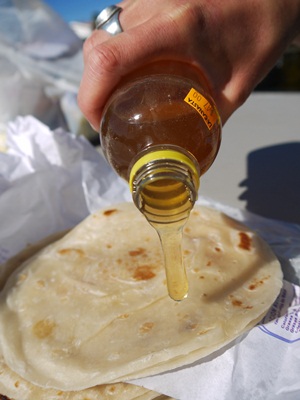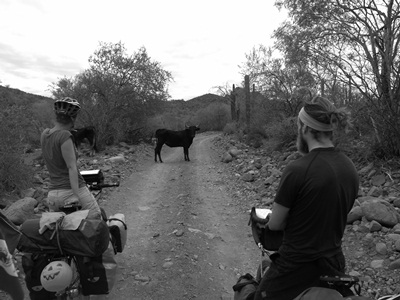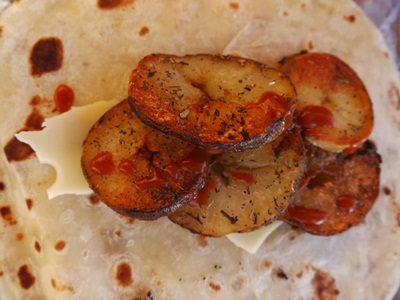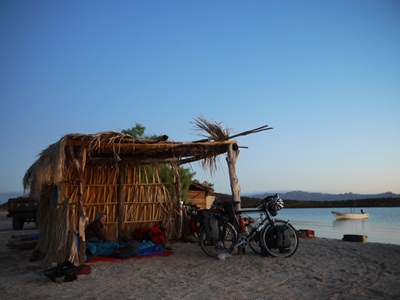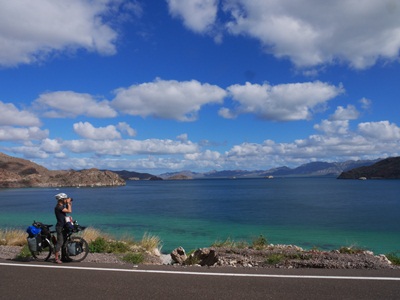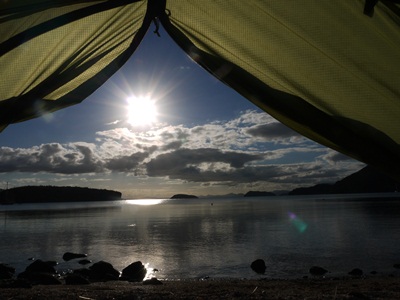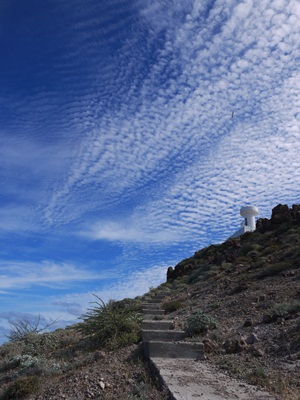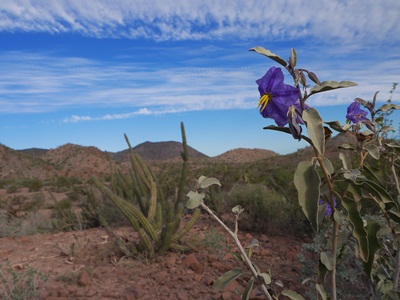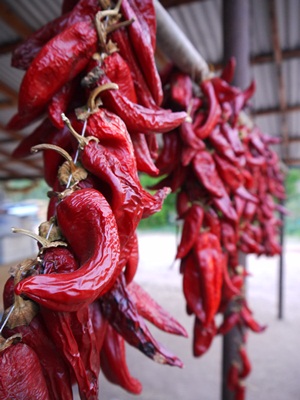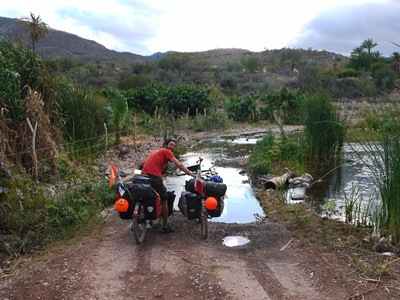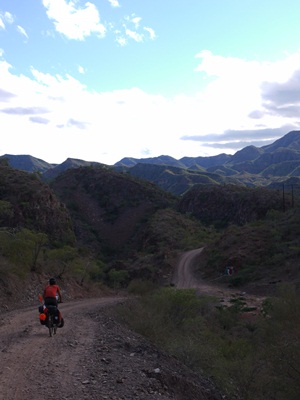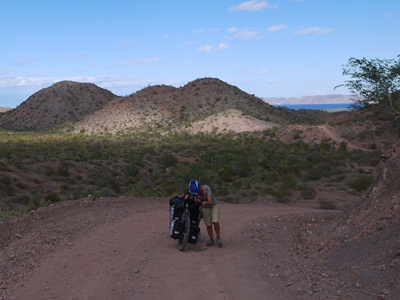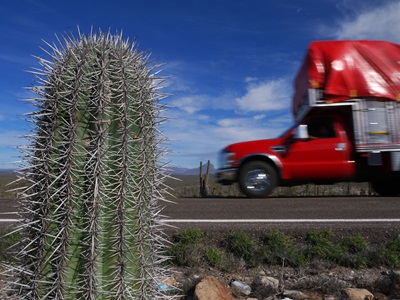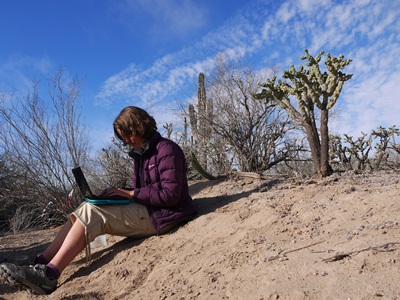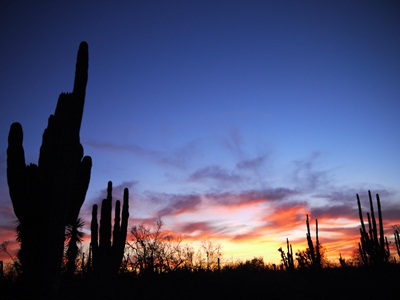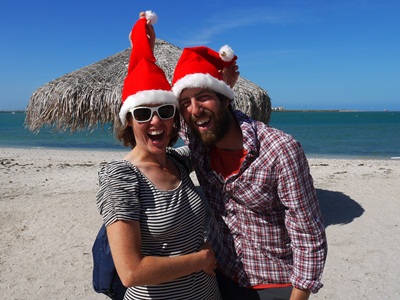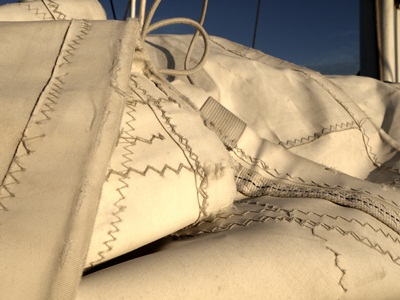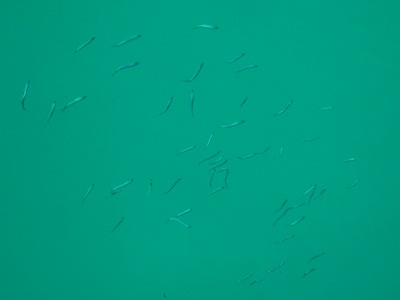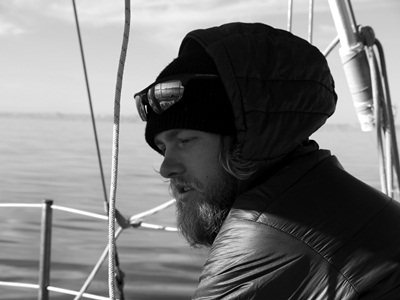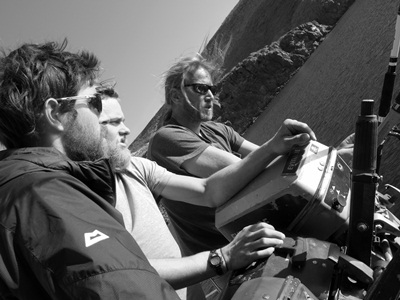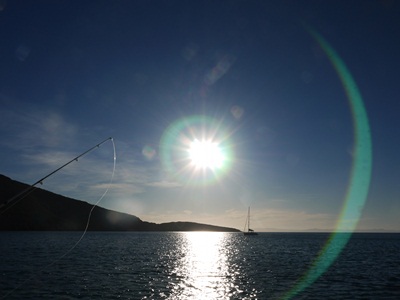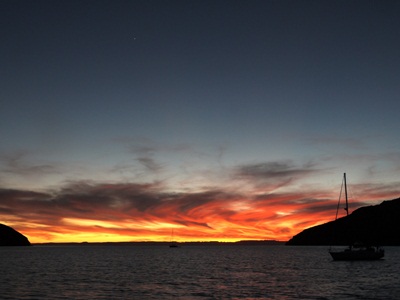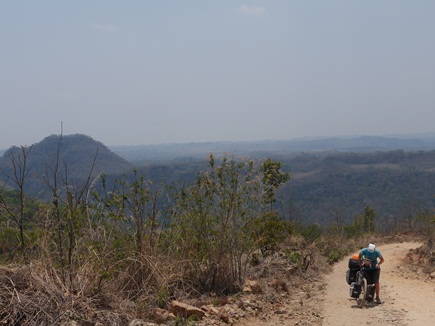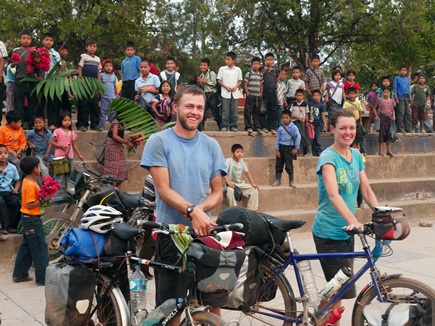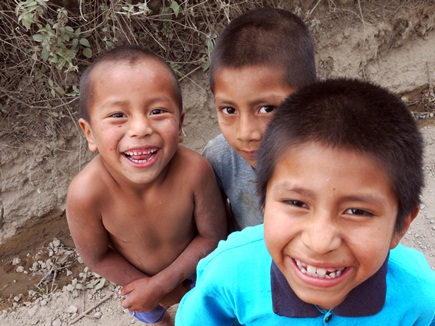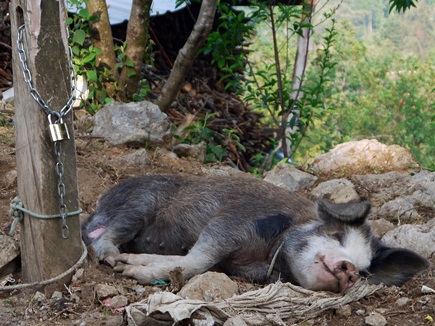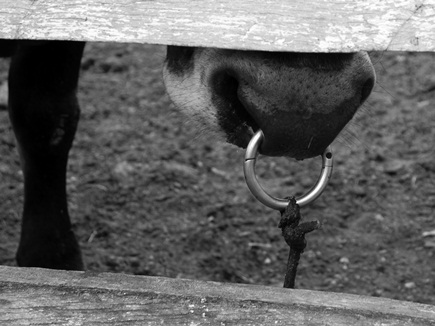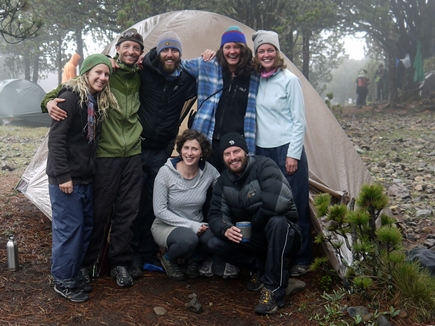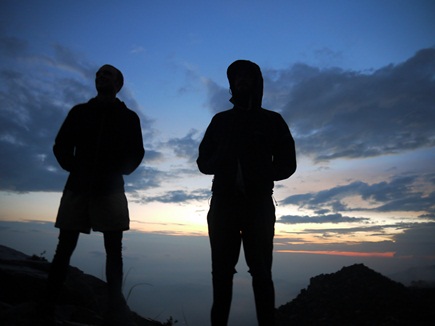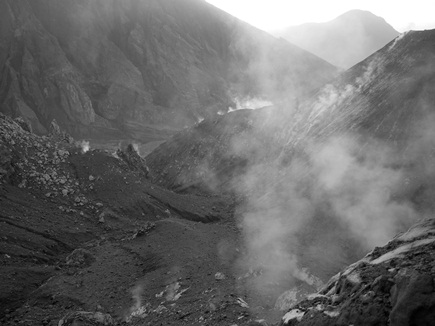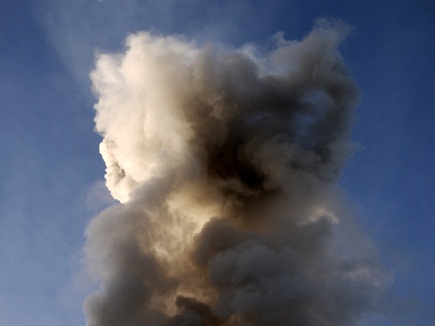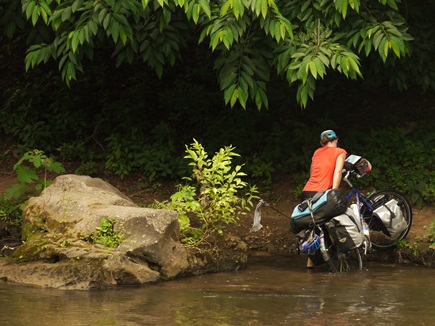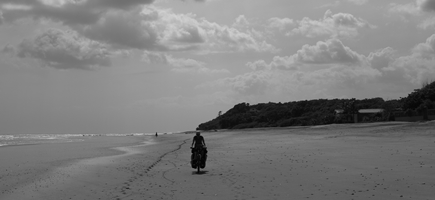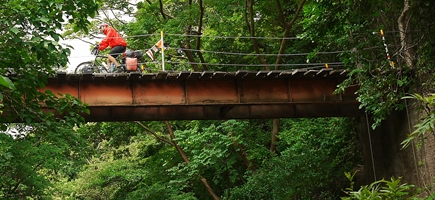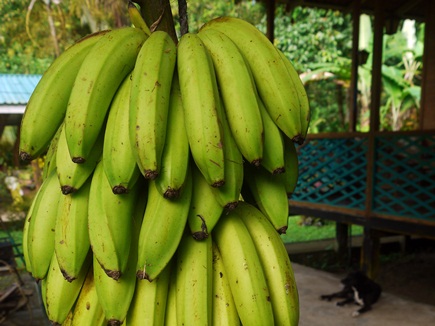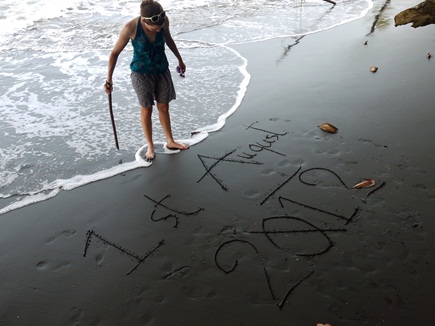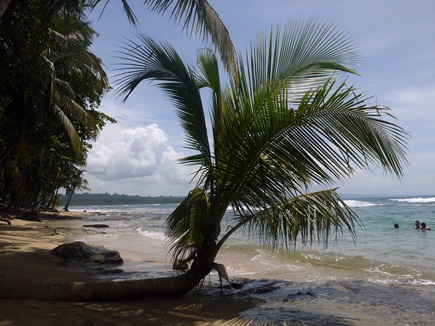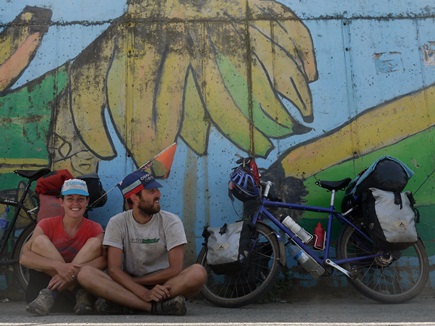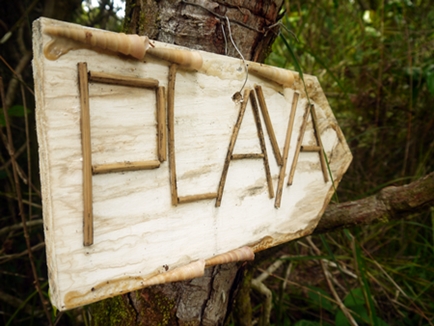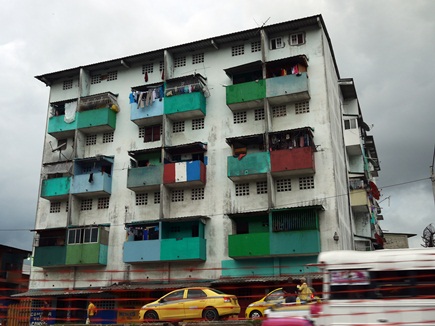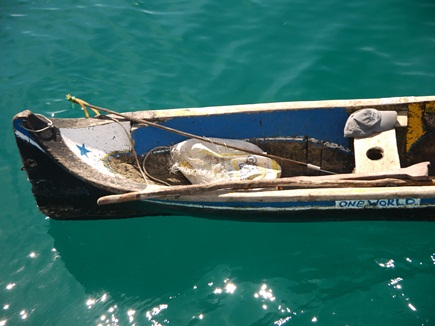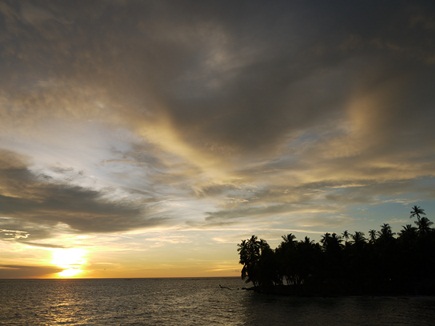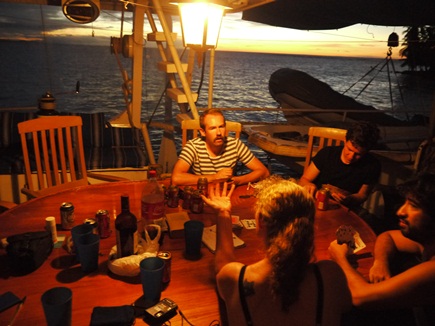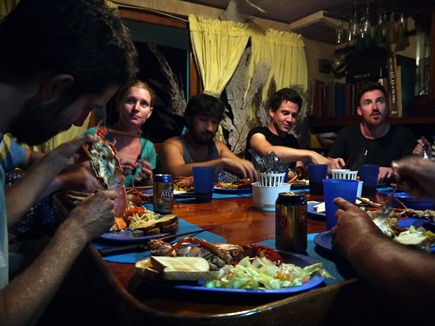Baja Sur – picture gallery
December 31st, 2011
A small selection of photos from the last three weeks of cycling the Baja peninsula. Amongst other things, the southern section of Baja provided us with plenty of wild desert camping and a dirt road detour to the “garlic capital of Baja” – where we were five months too early for the new garlic but we did get a look at the leftovers from last year…
We had more beautiful beach camping, particularly at Playa Juncalito where we spent three very relaxed nights and then at Casa de los Sueños outside of Mulegé, a real find through Warmshowers. Many many thanks to our host there, Fabian, who generously shared a private beach with beautiful views, kayaks for paddling over to the nearby hot springs and supplies for the road.
Sarah
Sailing on the Sea of Cortez
January 5th, 2012
Arriving in La Paz on Christmas Eve, we treated ourselves to a bed, a much-needed shower and a festive feast of tamales, fish tacos and roast chicken. It turned out quite a few other Pan-American riders had decided to do the same, and we spent time catching up with Lee and Andy, and met Ruben and Heidi from the inspirational Pedal Powered Family.
We headed down to the marina to see if we could find ourselves a passage across to the Mexican mainland, and came away with an even better offer. Michael was heading out into the Sea of Cortez for five days of snorkelling and fishing, and invited the three of us along to crew on board his 46-feet yacht Fan.
We jumped at the chance to swap pedal power for wind power for a few days, and it was bliss. I can’t think of a better way to wash off the desert, wrap up our Baja experience and celebrate almost six months on the road.
Michael had recently bought Fan as a working project in San Francisco, and sailed her down to Baja for the winter.
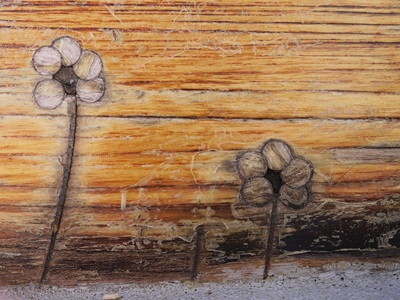
Home-built by a carpenter, Fan is full of character with beautiful wooden details such as these flowers above deck. Michael has plans to renovate her fully in 2012 to bring her up to scratch and ready to sail anywhere!
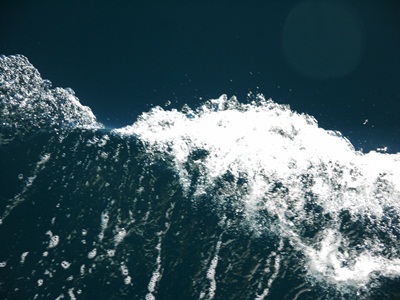
…the sails were up and we were underway. We headed north out of La Paz into the Sea of Cortez, the incredibly rich body of water which separates Baja from the mainland and which Jacques Cousteau famously called “the aquarium of the world”.
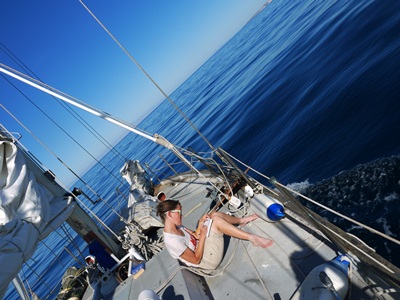
After a couple of days finding our sea legs (and stomachs), we worked our way along the sheltered coves of Espiritu Santo Island, quickly settling into a tough routine of reading…
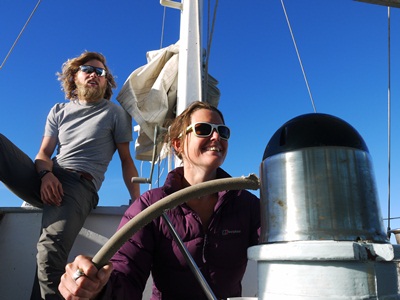
…and despite her track record for wayward steering, even let Bedders take to the helm (no punctures this time you'll be pleased to hear).
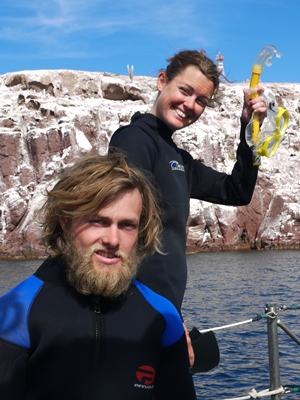
..but we did get lucky with an incredible afternoon spent snorkelling at a sea lion rookery. The pups inquisitively swam right up to our faces to check out the strange gringos in wetsuits, while the adults torpedoed below us with incredible power and grace.
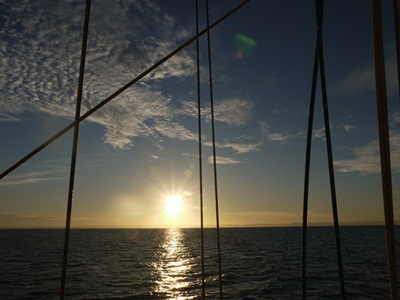
At the end of each day we were treated to a spectacular Baja sunset show, as the sun dipped towards the horizon…
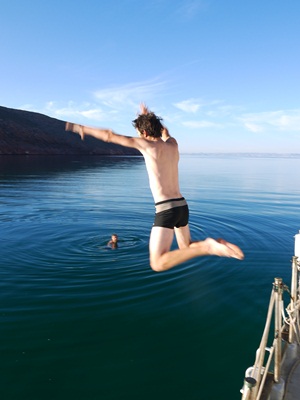
And what better way to celebrate New Year's Day than an early morning leap into the Sea of Cortez! A very Happy 2012 to everyone – to friends and family back home, but also to all the new friends we met and who helped us along the road in 2011. Here's to more Latin American adventures in the coming 12 months…
James
Hitting the wall
May 24th, 2012
We sat at the side of the road, bikes thrown down in disgust, and glared at each other. Silently we blamed one another for our situation – but the real cause was another brutal, seemingly vertical stretch of Guatemalan climb which lay between us. Tears were rolling down her cheeks, and after three days of slog, I knew that there was no way we would be climbing any more. In silence we turned round and rolled back down the valley to the town of Todos Santos and a waiting bus, covering in five minutes a distance that had just taken us two hours to climb.
To any non-cyclist, I can imagine this sounds incredibly melodramatic. If a hill is too steep to cycle up, then of course you just get a bus. What’s the big problem? Who cares? No-one of course. Except that we did care – because for the first time in 10 months and 10,000km, we’d had to admit that we couldn’t actually cycle this road.
Of course, we’d “cheated” before – like skipping most of Canada on a long ferry ride, or taking a boat out from Laguna Miramar just a few weeks earlier in Mexico. But on those occasions we had deliberately chosen not to ride in exchange for another experience. This was different. In the ongoing battle of touring cyclist versus road, for the first time the road had won. And to a pair of stubborn cyclists who thought they could ride up anything, that was a hard thing to swallow.
I guess I knew that eventually we would find our limit – but I had thought it might be in the mighty Peruvian or Bolivian Andes, rather than here in the little-known Cuchumatanes of northern Guatemala. At least then, there would have been some element of honour and glory in defeat – I mean, who would try to cycle through the Andes anyway? But I had underestimated just how steep this wall of mountains that welcomed us to Guatemala were.
Of course, as usual we hadn’t helped ourselves. In our constant (and to everyone else, probably rather tedious) quest to ride the road less travelled, we had avoided the main route from Mexico into Guatemala with its smooth tarmac and well graded hills. Instead we chose a circuitous back door route which our map classified as “seasonal track” and in reality meant three days of sweating, swearing and a lot of back-breaking pushing.
We sat in disconsolate silence as the bus crawled its way back up the hill past the point where we had turned back, our bikes expertly lashed to the roof alongside sacks of maize and half a dozen chickens. There was no pleasure in the cheat; no satisfaction in avoiding the sweat and toil of crawling our way up the hill. Both of us would have given anything to have been out there riding. For once, I concluded, the plan had backfired. We weren’t really the globe-trotting, off-road “adventure” cyclists we had hoped we might be.
But the more I thought about it, the more I realised it really hadn’t backfired. Firstly because no-one really did care if we had taken a bus or not. On that front, we just needed to swallow our pride and take ourselves a little less seriously. But mainly because if we hadn’t attempted the route we had just ridden in the first place, then we would have missed three days of incredible experiences amongst the sweat and tears : a river crossing without a bridge, a night camped in a municipal hall with an audience of schoolchildren, and a village football match with locals in their traditional dress.
It sounds like a terrible cliché from a motivational speech – but I realised that the real failure would be to take this experience to heart, and to stifle our curiosity for the roads less travelled. It would be easy to start choosing the obvious path, the nicely tarmaced but traffic-choked and monotonous roads we try to avoid. But we would have many more regrets.
Instead we should stick with our approach of seeking out more interesting and challenging routes – but just with a touch more pragmatism thrown in. Like choosing tracks that we can at least occasionally ride on, rather than footpaths that leave us pushing for hours. And if we have to take a few more buses, then who cares? At least we will always know that our experience will have been be so much richer for trying.
James
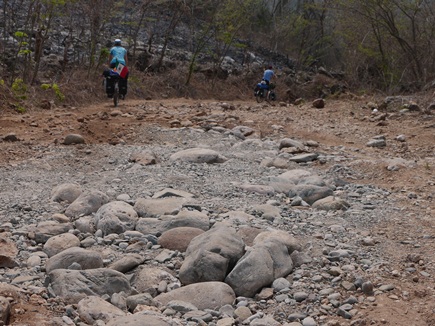
After an easy downhill coast from the Mexican border to Nentón, we had two options to take us up into the Todos Santos valley: a round-about tarmac route, or an intriguing dirt road “shortcut” from Nueva Catarina to San Andrés Huista. We deployed our usual tactic of taking a straw poll of three locals; one said the dirt road was rideable, two said we had no chance. Needless to say, we chose the dirt option…
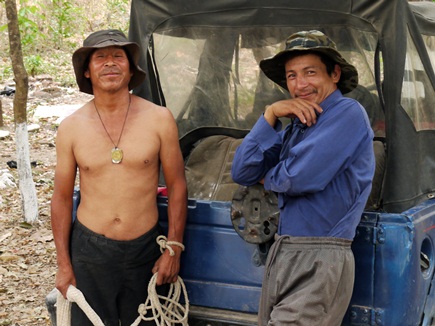
Fairly soon we faced our first challenge – the bridge across the river at Vieja Catarina had collapsed years ago. Fortunately, these two friendly fishermen were on hand to help us find the best crossing point…
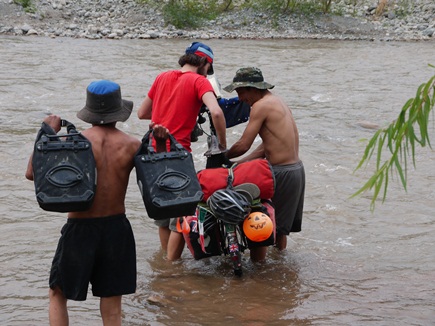
…and to help us wade across. A few weeks later and with the onset of the rainy season, we might have been swimming.
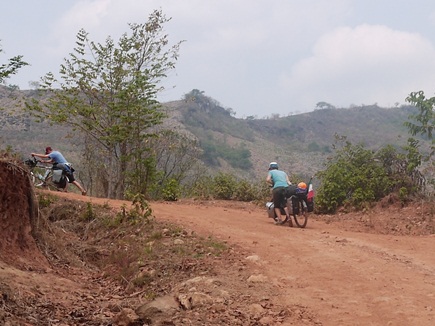
Our fishermen friends assured us that the road ahead was rideable – but within minutes we were off and pushing. Loose earth, a 20% gradient and fully loaded touring bikes do not mix well.
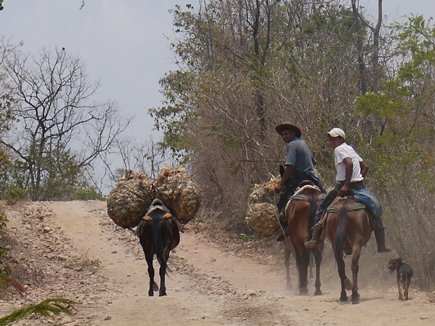
…much to the bemusement of locals, who far more sensibly opted for horse-powered transport to collect their firewood.
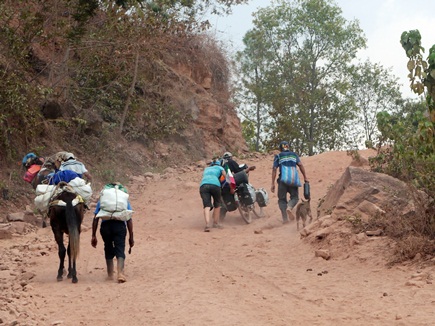
After five hours of back-breaking pushing, eventually we reached the outskirts of San Andrés – where some villagers took pity on Bedders to give her a running push up the final hill.
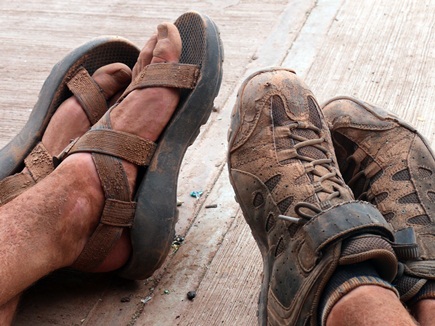
There was no way we were going any further that day, and so we collapsed in a dusty heap and attempted to revive ourselves with coke and chips from the ever-present Guatemalan fried chicken stall.
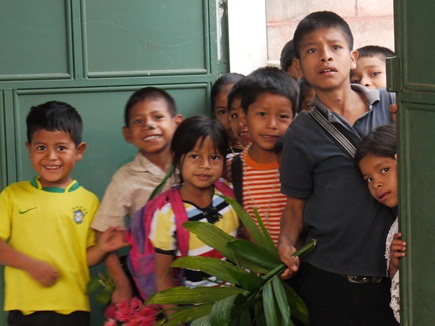
After introducing ourselves at the mayor's office, we were given permission to camp in the village hall – a covered space enclosed with metal bars which we quickly christened the Gringo Zoo. We woke in the morning to the entire population of the nearby primary school peering through the bars at the strange visitors…

Their teacher explained that most of the kids would only ever have seen “people like us” on TV – which explained their fascination with us, our bikes and especially with our cameras.
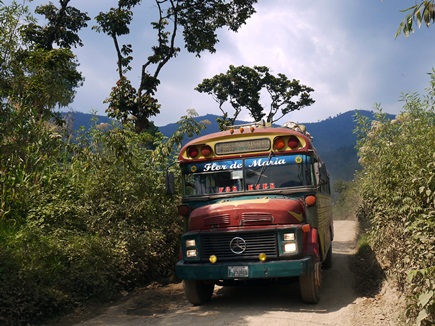
Over the next two days we continued to climb slowly up through the beautiful valley towards Todos Santos – dodging chicken buses coming the other way…
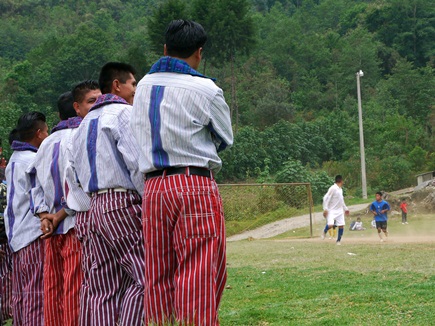
Stopping to watch a village football match gave us the chance to admire what must be the coolest traditional dress going – striped pyjama-style trousers and a high collared shirt…
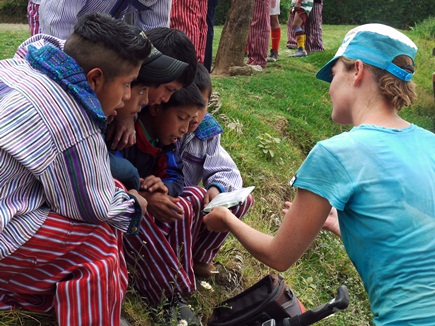
…while the locals were equally intrigued to see where they lived on our map, and find out where the weird gringos on bikes had come from.
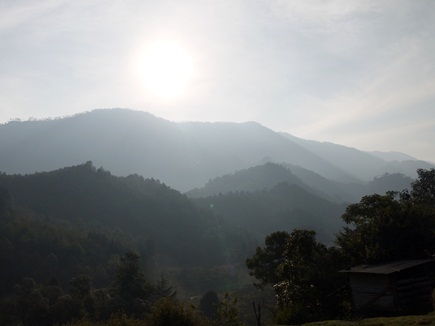
After being invited to camp in his half finished house by Jovel, a friendly local, we headed on up towards Todos Santos in the early morning light…
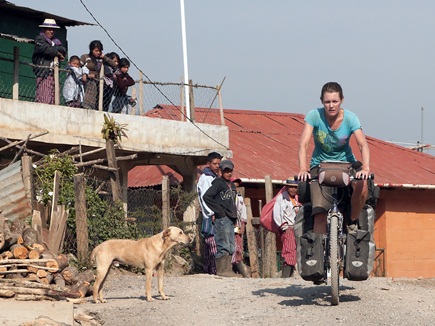
…and more curious bystanders. After lunch in Todos Santos, we set out on the climb that would eventually defeat us and have us coasting back down the mountain in search of an escape by bus.
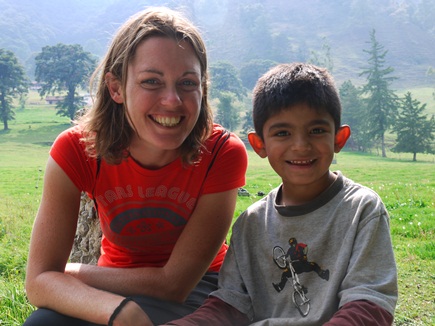
After a night in Chiantla, Lee set off directly for Xela, while we headed east towards Nebaj. Here we abandoned the bikes to walk through the mountains to the beautiful village of Acul, set in a deep valley and surrounded by lush Alpine scenery. We'd heard rumours of a local farm producing swiss-style cheese, and so we set off with our guide Carlitos to successfully satisfy our craving…
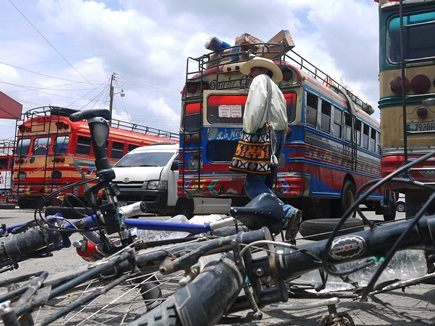
Our plan had been to spend the next couple of days riding to Xela via Santa Cruz del Quiché, but once again things didn't quite go to plan. The hideous sulphurous odours emanating from my every orifice told me that my giardia was back with a vengeance, and reluctantly we were once again forced to pile our bikes and belongings back onto a bus, and take the easy option out.
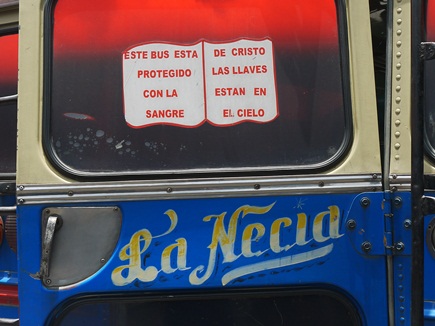
And so we headed for Xela, where we planned to spend the next few weeks in language school brushing up on our Spanish grammar. At least we were assured of a safe ride there on our chosen bus: “This bus is protected with the blood of Christ – the keys are in heaven”.
A tale of two volcanoes
June 6th, 2012
In a country split down the middle by a string of beautiful and restless craters, climbing volcanoes is a rite of passage for every traveller passing through Guatemala. From my previous time here, I had vivid memories of sitting atop Tajumulco, the highest peak in Central America at 4,220m, and gazing out towards Mexico and the Pacific as the sun rose through a beautiful sea of clouds.
Inspired by this experience, on our second weekend in Xela we headed out to climb Tajumulco on a hike organised by Quetzaltrekkers, an excellent not-for-profit and volunteer-run trekking co-operative. Unfortunately the anticipated sunrise was not to be, as the clouds rolled in, the rain lashed down and we peered out into the mist.
It all would have been a bit miserable, if it wasn’t for the fact that we were lucky enough to find ourselves with a great bunch of people. Partly due to the altitude, but more thanks to the unique ice-breaking skills of Dave, a nurse from Colorado, shivering in a soggy tent at 4,000m has never been so much fun.
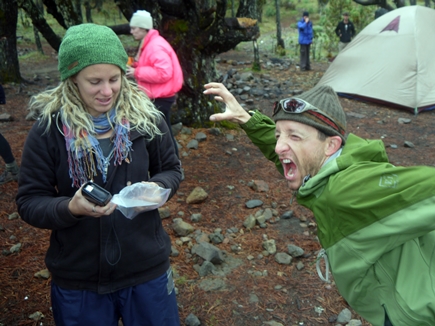
Dave the Naughty Dragon tries his moves on Claire. Oscars night will never be the same again thanks to Dave and Amanda Weeks.
As luck would have it, one of our guides on the Tajumulco trek was Nathan – a fellow Brit and PanAm cyclist who’d spent the past few months living in Xela and volunteering for Quetzaltrekkers. After a collective love-in over our mutual appreciation of Thorn bikes, Cass Gilbert, and going very slowly, Nathan invited us to join him the following weekend on his final trek before resuming his ride south.
After a week of limping around the streets of Xela, Bedders very sensibly declined and opted for some local hot springs followed by wine with girlfriends – while Nathan and I set off with fellow guide Jamie for a weekend climb up to the bizarre landscape of Santiaguito, apparently one of the ten most active volcanoes in the world.
It was an incredible, surreal experience which this time left me hobbling around like a 90 year old for the next week. Yet the aches and pains were well worth it – as we all agreed before we went our separate ways, it was a truly memorable way to bid farewell to Xela.
James
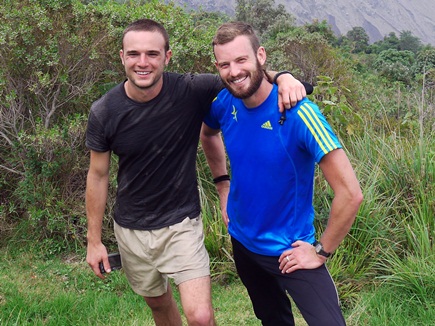
My guides for the weekend: Jamie from Colorado and Nathan from Reading, who started his PanAm bike ride south from Alaska nearly two years ago.
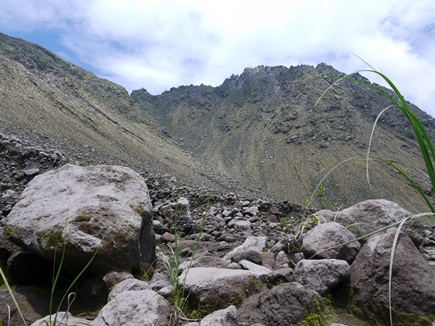
After hacking our way down through thick vegetation and some spectacular and mostly unintentional slides down a polished rocky ravine, we reached the boulder field at the base of Santuaguito. Next up was a sweaty scramble towards our campsite…
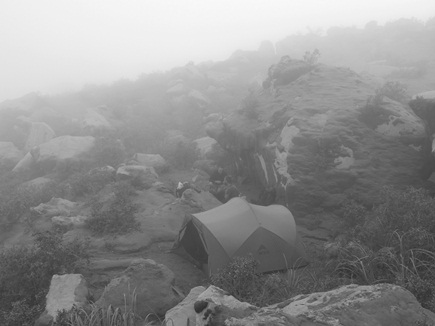
…which we reached just as the clouds rolled in and the rain started to fall. We huddled in our tent while Santiaguito, eerily invisible in the mist but less than a kilometre away, rumbled loudly as it erupted every 30 minutes or so.
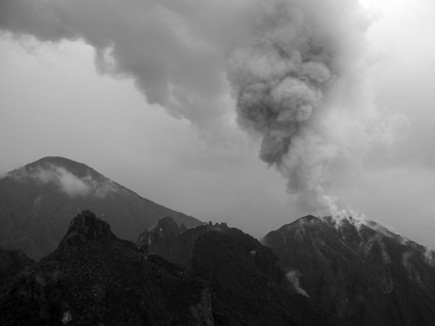
…revealing Santiaguito for the first time, ominously spewing ash and steam and dwarfed by its mother volcano Santa María in the background.
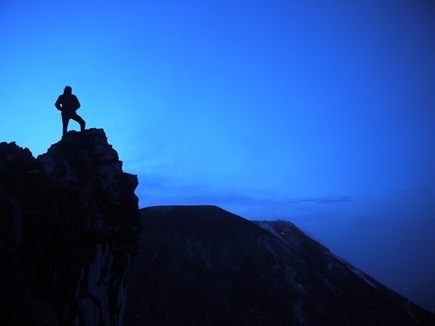
Up at 3am the following morning, we scrambled in the dark up towards the crater, until we were perched just a few hundred metres away.
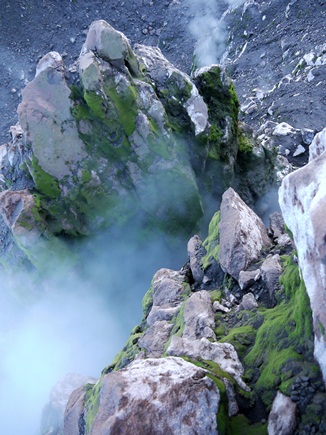
…broken only by splashes of bright green moss which had sprouted since the start of the rainy season only a few weeks earlier.
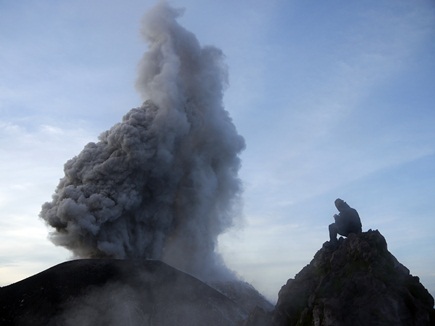
Needless to say, we didn't have long to wait before the steam grew in intensity, the deep rumbling began, and a cloud of ash was launched high into the air above our heads…
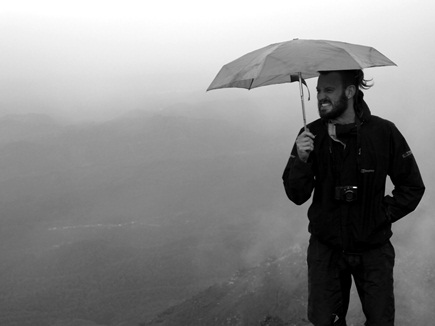
Showing his pro guiding skills, Nathan pulls out his brolly in preparation for the ash shower that followed every eruption.
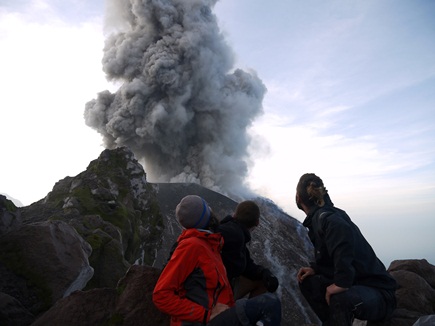
After watching a few more eruptions, we set up the obligatory group shot. Right on cue, Santiaguito obliged with a final spectacular effort which had us gawping over our shoulders.
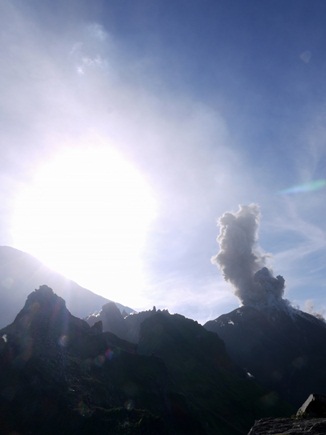
Back at camp, we tucked into breakfast with a final chance to soak up the spectacular backdrop. All that was left was a tough slog back up and out to the road, before falling into a bus back to Xela; exhausted and filthy, but grinning and happy after a unforgettable weekend.
Rediscovering our rhythm
July 8th, 2012
I don’t want to tempt fate but I am in a cheerful optimistic mood so I am going to say it anyway – we are both feeling much better. Parasites are either gone or dormant for now, hills are not quite so steep and the muscles in our legs are remembering how to turn the pedals on our bikes for six hours a day. We’re back in the swing of cycle touring. It seems like it’s been a long time since we felt like we had the remotest idea what we were doing….but you know what they say about riding a bike…
Our final days crossing Guatemala settled into a reassuring rhythm of filtering endless litres of water, sweating, preparing porridge and coffee as always for breakfast, sweating, climbing hills, drinking carton after carton of super sweet Central American chocomilk, sweating, climbing hills, and discussing latest bowel movements with a new cycling companion: Nathan. None of this is particularly interesting or glamorous, in fact some of it is entirely disgusting but it’s our familiar routine nevertheless and it feels good to be back.
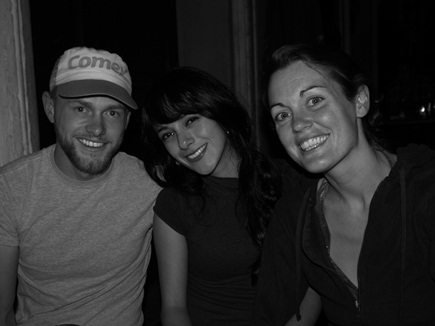
Before we left the comfort zone to return to an almost forgotten cycling trip we'd embarked upon, we went for drinks with my fantastic Spanish teacher Alma and our old cycling comrade Lee. He'd been in Xela a week longer than us and caught the Quetzaltenango bug, deciding to stay in town to teach English, salsa dance and generally put down roots for a while. We hope to see him along the road somewhere….
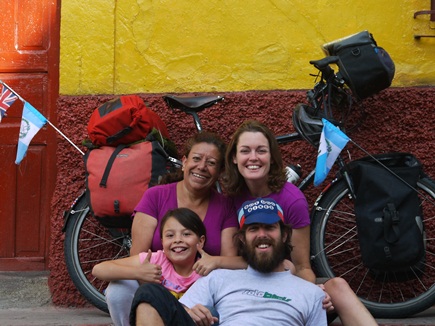
No more procrastinating, the two of us hit the road early on a Sunday morning, leaving behind our wonderful host family whilst we'd been at language school. Patti cooked us amazing food, encouraged my fledgling attempts at Spanish and gave us the warmest of Xela welcomes. We hope to return to her and her delicious tamalitos one day.
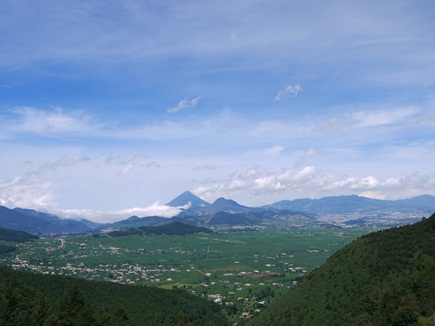
We set ourselves a fairly hefty target on the first day back on the bikes after a month, aiming to reach Lake Atitlan, more than 80km from Xela. We had sunny skies and the twin peaks of Santa María and Santiaguito to look back on as we climbed a short section on the Interamericana highway to its highest point, and then rolled down towards the lake picking up a police escort along the way.
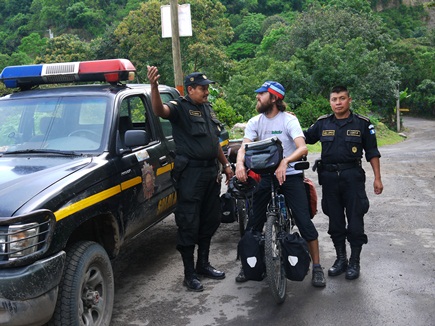
“I am arresting you for crimes against facial hair”…These guys were either bored on a Sunday afternoon or else genuinely concerned for the welfare of cycling tourists; whichever it was they did a thorough check on our details, sternly warned us that the road ahead could be dangerous and offered to escort us to the village on the the lake that we were headed for. We accepted their offer and sheepishly rode into San Marcos behind their cruiser.
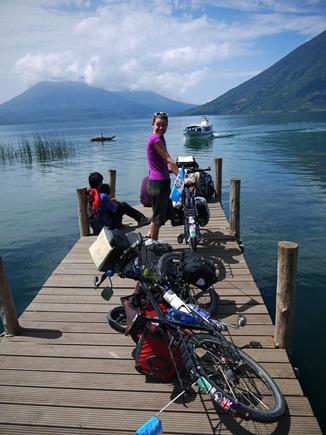
Movement between the villages and towns dotted around Lake Atitlan is easiest by lancha and so we prepared to throw the bikes onto one of these little boats and move on to Santa Cruz for our second day on the lake.
We arrived at Santa Cruz and checked in to a beautiful lakeside retreat called Arca de Noe, in sight of Volcan San Pedro. James had stayed here a few times more than ten years previously, whilst he was living in Guatemala City and remembered it as a peaceful, beautiful place.

He was right. The perfect place to sit amongst the flowers, sip strong coffee, gaze at the volcano, listen to the sounds of the lake and………..relax.
We liked Arca de Noe so much we couldn't help ourselves and stayed an unplanned extra day – thank you to my wonderful, generous family who put birthday presents into my bank account, you paid for our lovely second night here! We ate delicious homemade pasta made by the manager Christian, who is originally from Patagonia, and has kindly offered to hook us up with friends and family of his when we reach Argentina. We're already looking forward to meeting his contacts somewhere along the road.
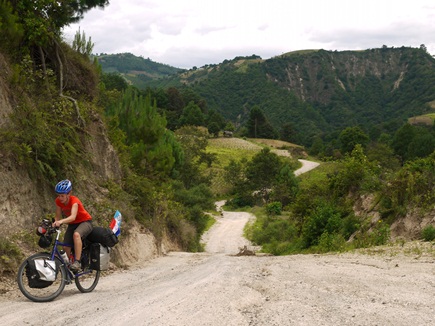
After our difficulties with dirt roads and hills before arriving in Xela, we decided to look the problem in the face and tackle a few on our way between Lake Atitlan and Antigua to make sure we hadn't become allergic.
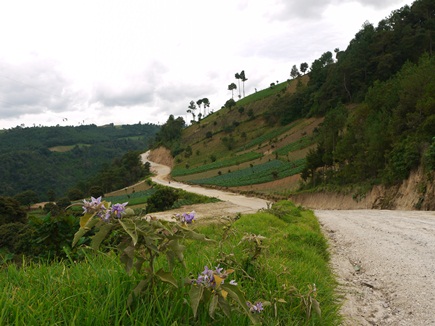
This great dirt track was perfect, tough but not too steep with beautiful views and then a great descent.
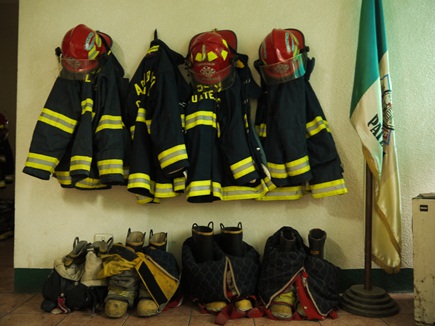
Reaching Patzicía, we found there were no cheap hotels but someone recommended we have a chat with the guys at the local fire station. Next thing we know we're all set up with a comfy bed in one of their dorms and use of their kitchen facilities….
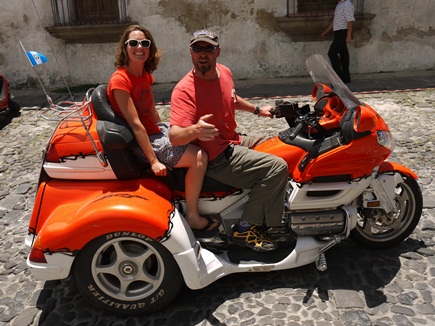
Arriving in Antigua, we went to find Dave, who James knew from his previous time in Guatemala; they volunteered at the same charity and then cycled from Guatemala City to Panama together. Dave now runs his own motorbike touring company out of Antigua and in his spare time, likes to zoom around on this crazy trike that he recently picked up from West Virginia. He's heading down to Colombia on it this summer, so we expect to be looking out for this orange beast along the road in a few weeks' time.
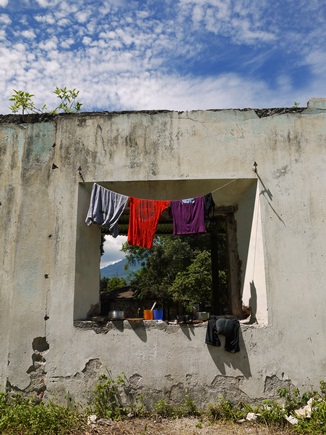
The tourist police compound in Antigua gave us chance to catch up on some washing, to dry out our stuff and enjoy some free camping in the heart of Guatemala's most touristy city.
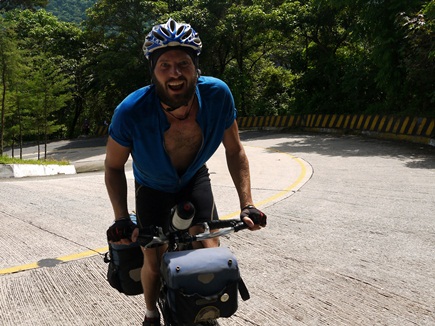
Joined now by Nathan, a British touring cyclist who we met in Xela, we left Antigua and set off with excitment towards the Honduras border…or so we thought. It was a lovely ride but our first day out of Antigua was a non starter. It saw us take a 10km wrong turn, and then be turned back on the correct road because it was too dangerous and so we ended up back in Antigua where we had started.
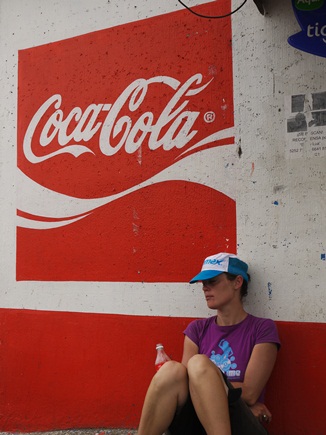
The next day everything went a little more smoothly and we took a long steady climb out of Antigua by a different road. Lunching on a roundabout, and fuelled by Coca Cola as always, we ended the day in a shabby hotel in San Juan Pinula, to celebrate Nate's birthday with takeaway pizza and a couple of cold Guatemalan beers.
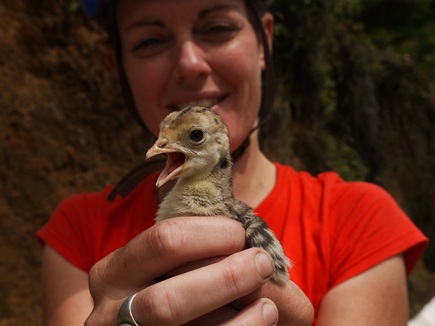
Climbing out of Mataquescuintla (yeah, try saying that after a few cans of Strongbow!), we found this turkey chick by the side of the road. He evidently thought he could fly and dropped off a high perch about ten feet above. Being a long time frustrated veterinarian, I scooped him up and returned him to his family.
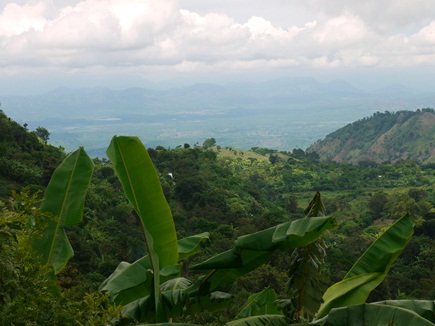
This corner of Guatemala, up in the mountains, is beautiful. Our days here were all about getting up early to beat the lunchtime heat, cycling up big hills, wowing at marvellous views, stuffing ourselves on pan dulce, setting up camp or finding a cheap hotels and then seeking out newly discovered hula hoops…they're almost as good as the ones back home, but to my dismay, unfortunately they don't come in salt and vinegar flavour.
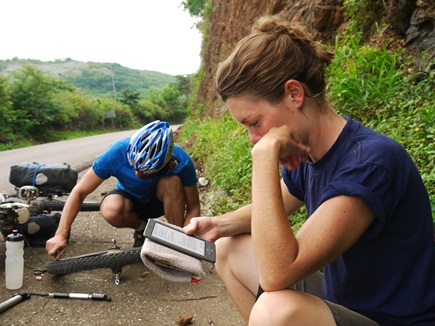
Our last day in Guatemala, headed for the Honduras border was going to be a big one and to make it we had to get up super early and couldn't really afford many stoppages or delays. Things didn't quite go to plan as punctures don't really tend respect your schedule; just half an hour into our ride, Nate found himself changing a puncture on the back wheel…while I helped out by reading my book…

Trying to get rid of the last of our Guatemalan Quetzales before we crossed the border, we bought some healthy and nutritious snacks: biscuits, an ice cream each and one more to share…I look worried because I am anticipating the terrible state of my teeth by the end of this trip if we keep up this routine of sugar based snacks.
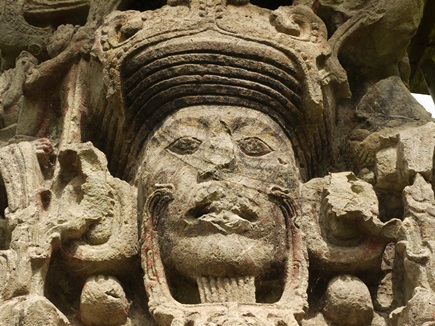
Once into Honduras, we visited the ruins at Copán. The site was peaceful and well preserved. The ruins date back to AD250-900 and amazingly the beautiful detail and hieroglyphics remain.
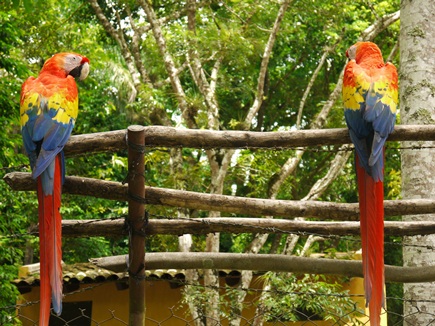
The site at Copán is also home to lots of noisy macaws who are making the transition from a nearby bird sanctuary back into the wild. The flashes of colour from their vibrant feathers as they flew past was a stunning addition to the lush green canopy of the woods around the ruins.
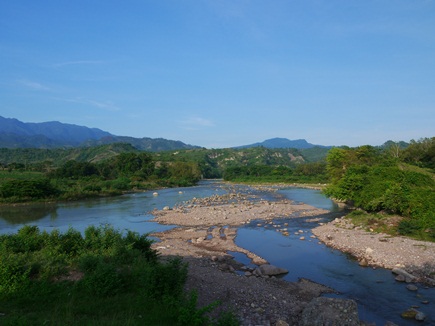
The journey between Copán and our next big-ish stop at Gracias was an undulating and pretty ride. Through valleys and over rivers like this one.
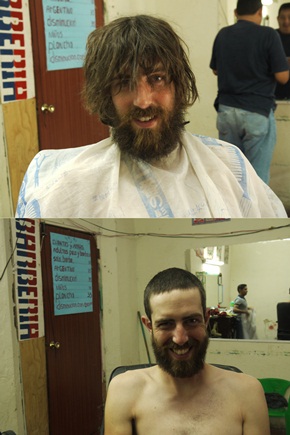
Once in Gracias, James, sufferng from the heat of Central America finally succumbed and visited the barber for the first time in the year to get his locks chopped off. Here are the obligatory “before and after” shots. All I can say is “…thank goodness for that!”
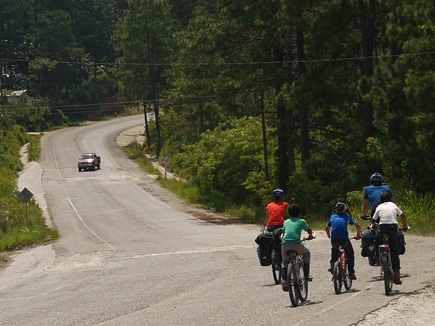
A hot and steady climb out of Gracias and into the rolling green countryside. Our morning break in this little village was witnessed by no less than seven local children, the shopkeeper, two dogs and a chicken. All watched us munch on bananas, gobble up biscuits and guzzle down Coke as usual and then we set off again, with Nate and I accompanied by the kids who escorted/raced us to the village border line – the local school.
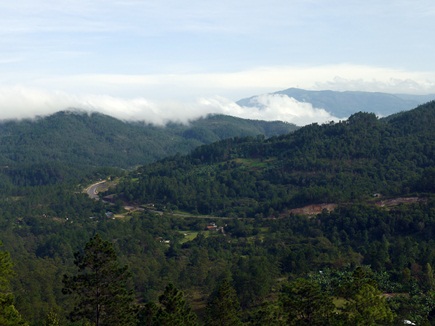
After an overnight stop camped in an ironmonger's workshop, we started a long climb up to Honduras' highest town, La Esperanza. Looking back at what we'd achieved halfway through the climb was a satisfying experience.

Unfortunately just a few minutes later, in what has also become part of our regular routine, and nastily interrupting the steady rhythm we'd acquired, we had stopped, removed my back wheel and set about fixing yet another puncture…this time thanks to a thin piece of wire on the side of the road that got stuck in my tyre.
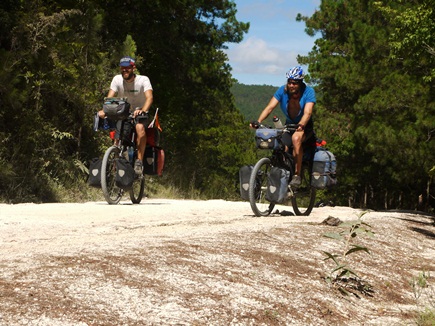
A couple of days relaxing in La Esperanza and we were off again on one of the most enjoyable roads we've ridden in a while. A dirt road took us away from town along a quiet back route to the border with El Salvador. It was of course hot but through beautiful pine forest with wonderful views. A ride to remember.
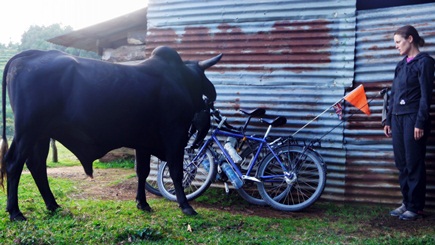
Close to the border we stopped at a military settlement for the night. The soldiers generously invited us to pitch our tents in their lovely grassy field without telling us that it was the grazing area for two very large bulls. This one took a keen interest in my bike, leaving a slobbering trail of drool all over my handlebars. I was not impressed and we slept with anxiety for fear of being trodden on in the night….
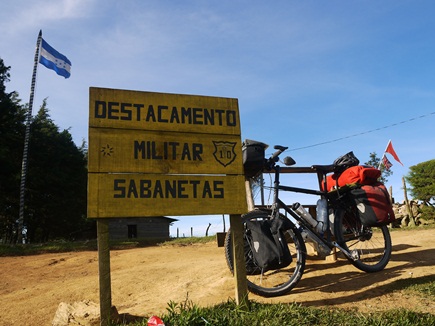
…thankfully, we woke safe the next morning, bid farewell to the soldiers (and the bulls) and set off for El Salvador.
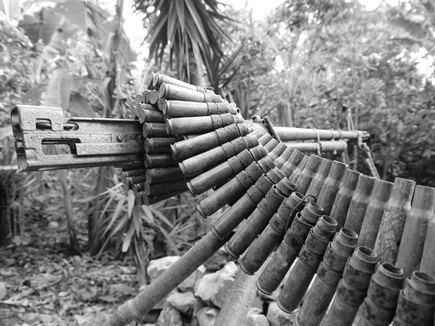
The border crossing was straightforward enough and we rolled into the nearby town of Perquín. Notorious as a base for guerilla troops during El Salvador's civil war, we visited a reconsutructed guerrilla camp for an introduction to this new country.

Little did we know that we'd only be spending 36 hours in El Salvador. We thought it would take us at least a day longer to make our short cut through the north east corner of the country but the roads were fast and either downhill or flat so we were through in no time. Thankfully our one and only morning there was a beautiful one with views of mountains and trees through clouds and sunshine.
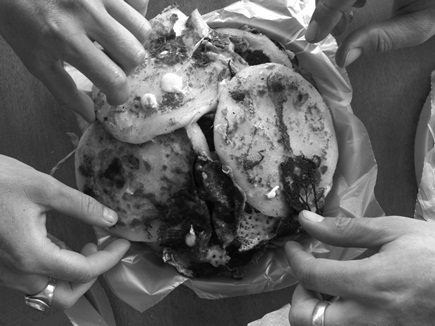
With such little time, we squeezed in as many of El Salvador's pupusas as possible. Maize dough stuffed with cheese…beans… or beans or cheese…or cheese and beans (spot the theme?) – then cooked on a hot plate; great for our raging hunger. We ordered a stack of them to share before crossing the border back into Honduras.

The short time we spent in El Salvador was a little confusing money wise as their official currency is US dollars so we were reintroduced to familiar notes unexpectedly…dollars are apparently also more commonly used in Costa Rica and Panama so we can expect to use them again soon.
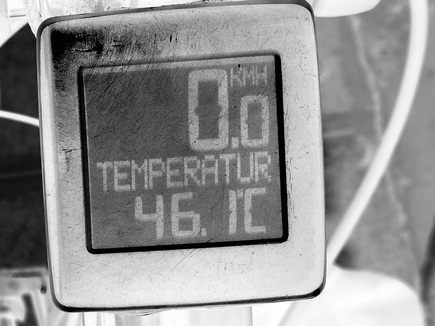
As I might have mentioned, we've been a bit hot. James' cycle computer confirmed what we already knew – just in case being drenched in sweat and eternally thirsty wasn't enough of a sign.
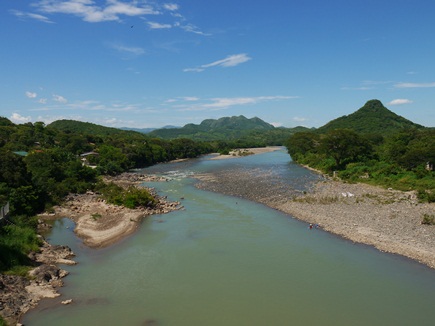
Back into Honduras from El Salvador and another crossing over another river – El Salvador on the left, Honduras on the right…
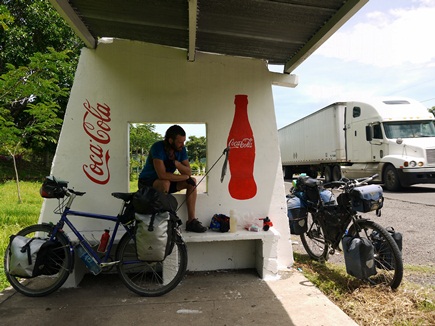
Our second time in Honduras was really mostly about making our way to Nicaragua. We had no option here but to take the Interamericana, the main route through Central America for heavy freight. The landscape has changed so much within the last week and now we're down at sea level and the roads are flat, busy, narrow and pretty boring….and of course hot! We searched for shade in bus stops and looked back to those dirt days in Guatemala and Honduras with fond memories.
Sarah
Nica beach cruising
July 15th, 2012
Riding the beach was something we’d long wanted to do on this trip – but so far it had never quite worked out.
Having battled the heat, trucks and tedium of the Interamericana for the previous few days on our dash across Honduras, we were keen to find an alternative route down through Nicaragua. And so, after a few days of rest and relaxation in León, Nicaragua’s revolutionary capital, we bid a sad farewell to Nate – who was off to the USA to buy some new tyres visit his girlfriend – and set off for the beach.
Our map showed a network of minor roads which in theory would allow us to keep west and track down the Pacific coast. On paper, it looked perfect – but not for the first time, our map was a triumph of optimism over the reality of Central American backroads. Gradually, the roads became rough tracks, then trails – and then disappeared entirely.
However – as has always been the case when we have given up on the map and relied on locals’ advice from village to village – it made for a memorable few days, and finally delivered our long-awaited fix of beach riding.
James
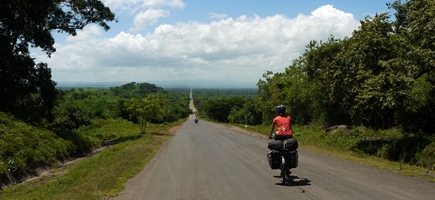
A welcome break from truck dodging – the almost deserted (and very straight) old highway from León to Managua. We followed this as far south as Santa Rita, where we turned off towards the seaside towns of Masachapa and Pochomil and stopped for lunch. We've learned that we always cycle better in the morning, and so the decision to stop to eat has turned into an epic battle of wills, as both of us fight to stave off the pre-lunch wobbles and churn out a few more km.
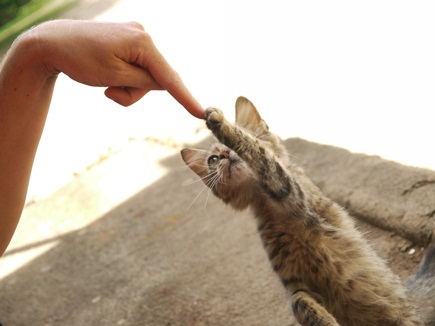
When one of us finally does crack, we fall into a heap at the side of the road – and almost always find a friend hoping for scraps. Needless to say, begging from hungry cyclists is very rarely profitable…
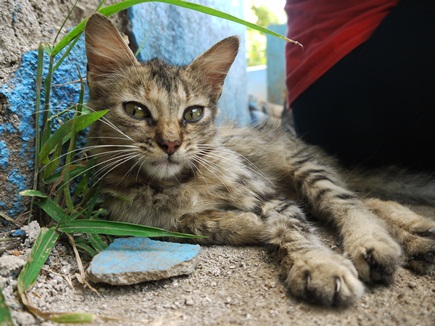
…even when you're this cute. If Bedders had her way, this guy would have been into her handlebar bag in a flash, and coming on a very long holiday.
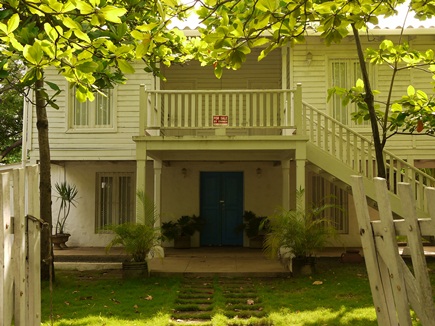
After a night in Masachapa, we headed along the coast to Pochomil. As the closest beaches to Managua, this stretch of coast used to be popular in the past with weekenders from the city, but with the rise of the more fashionable San Juan del Sur in the south it has a faded air. Desperate restaurant owners chased us along the beach for our business, and most of the luxurious beach-front homes like this one seemed to be up for sale.
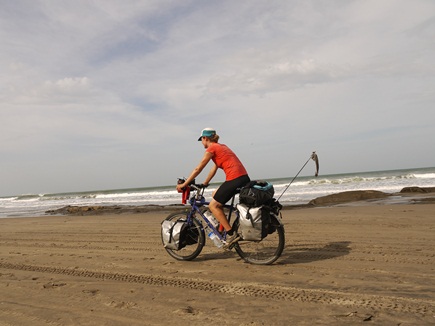
We started to ride the beach from Pochomil towards La Boquita – but were stopped by locals who told us with the tide coming in we would never make it across a deep channel which lay ahead. First lesson of beach riding – it's all about the timing.

Instead we cut inland, where we found a track which snaked its way through enormous sugar cane plantations and tiny coastal villages. Two friendly engineers from the plantation company on motorbikes stopped ahead at each junction to make sure we were headed on the right track.
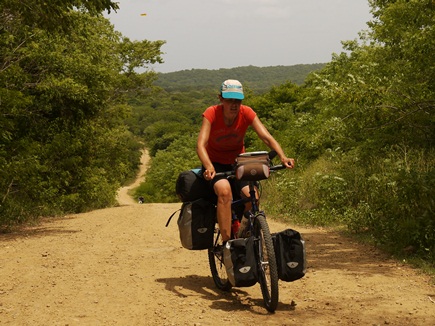
Remember Anneka Rice? Well let me introduce you to her Central America reincarnation: Anneka Rice and Beans. She's been revamped for a new eco-friendly generation, ditching the helicopter for a bike. She eats hills for breakfast…
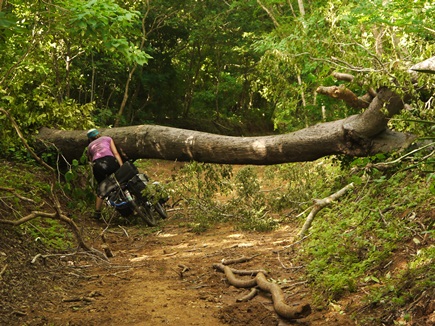
…and limbos trees just for fun. The question is – what happened to the all in one lycra suit? So far, all I've seen have been the shorts…
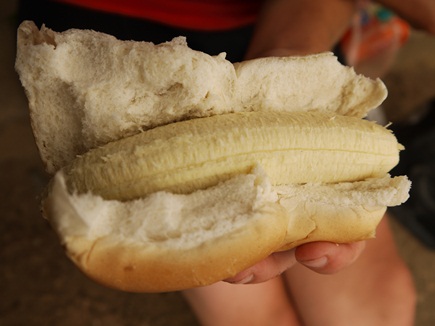
Bananas have taken centre-stage in our Central American diet. They're cheap, filling and – when added to a hot dog roll like this – distinctly gourmet.
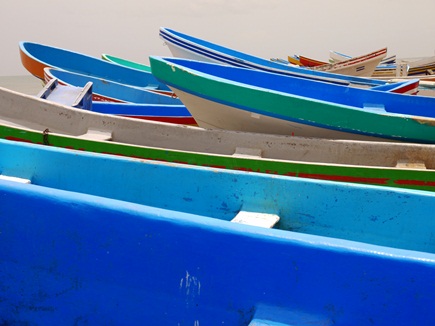
After popping out in La Trinidad, we hit tarmac again for an easy freewheel back down to the coast at Casares, the biggest fishing village along the coast. The boats were already hauled up out of the water for the day, and pigs snuffled amongst them looking for shade and scraps.
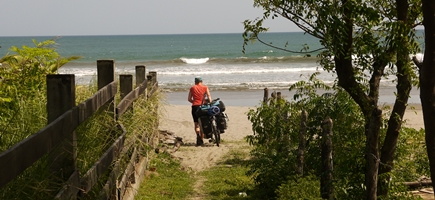
Beyond Huehuete, the “main highway” marked on our map came to an abrupt end – clearly the map makers' optimism exceeded the Nicaraguan government's funds when it came to road improvements. A quick consultation with some locals revealed that the beach was by far the best way to continue our route south – and this time we were in luck.
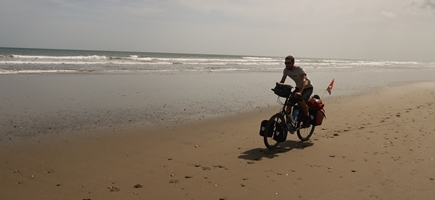
The tide was out, revealing a perfect highway of wet, hard-packed sand and a window of a couple of hours to reach the village of El Astillero 20km south, where we could rejoin the coastal road.
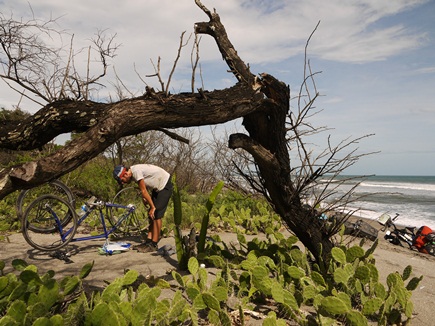
…SNAP! The metallic sound that every cyclist knows and dreads, and Sarah's first broken spoke of the trip. A quick beach repair and we were off again…then HISS! A puncture in the same wheel. Suddenly our window of time was looking very tight, and our water bottles almost empty. We decided to cut our losses for the day and find somewhere to camp.
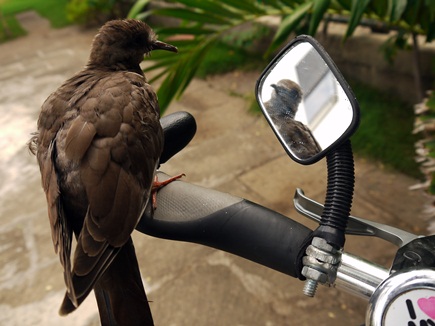
As always, it was a local to the rescue. Ramón was looking after one of the beachfront villas nearby and had watched us struggling with the wheel. He filled our bottles and invited us to camp. A dove provided the evening entertainment, preening itself in Sarah's mirror before attempting a bizarre and suicidal landing in our pan of boiling pasta.
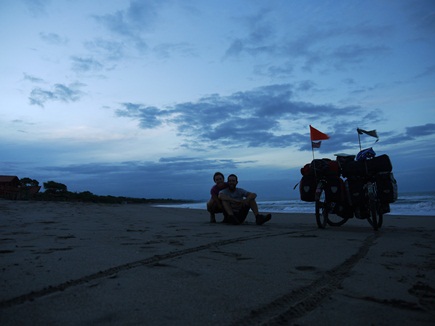
We were up at dawn, having worked out that we should have another window of time to ride the beach to El Astillero while the tide was out.
Some locals had beaten us to it, providing us with a perfect set of tyre tracks to follow. Squadrons of pelicans skimmed the waves just offshore, and hermit crabs scattered in front of us in every direction, racing to tuck themselves away inside their shells.
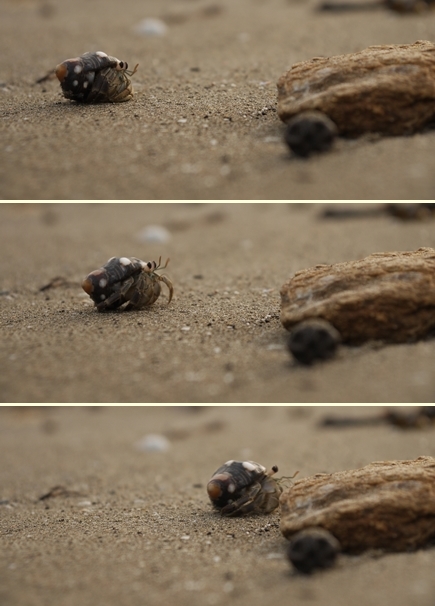
Stop for a minute though and they would nervously emerge: first, the eyes, like miniature periscopes; next a tentative claw; and finally, in a whir of legs, off they would scuttle.
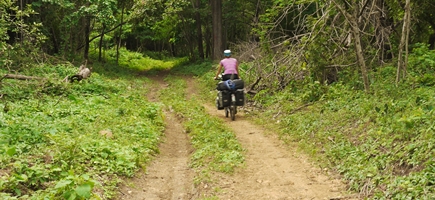
We made good progress for about 10km until just before Veracruz, where the beach once again became steeper and the sand deeper, swallowing our heavy bikes. We were stuck. Luckily some local fisherman were on hand to help us drag our bikes off the beach. They walked us inland and onto a beautiful track that they assured us would lead us south…
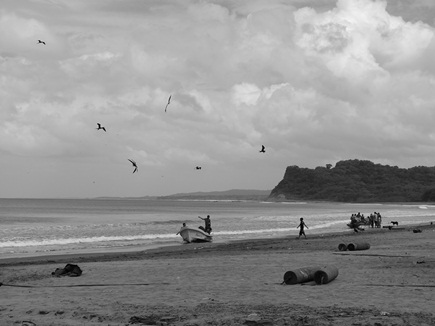
…which it indeed did. And so, 12 hours later than expected, we finally arrived in the fishing village of El Astillero – just as the morning catch was being brought in and sold along the beach.
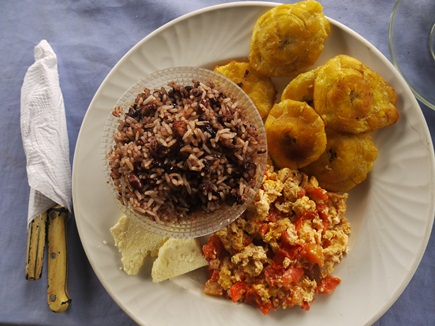
For me, there's only one meal better than breakfast – and that's second breakfast. We celebrated our beach ride with a typical Nica feast: gallo pinto (rice and beans cooked with herbs), tostones (fried plantains), scrambled eggs with tomato and onion and a slice of crumbly, fresh cheese.
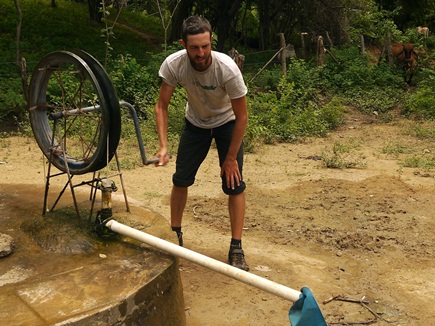
With our beach jaunt over for the time being, we turned inland again and headed across the narrow isthmus towards Lake Nicaragua, where we had planned a few days on Ometepe Island. First we stocked up on water from this ingenious bike wheel well…
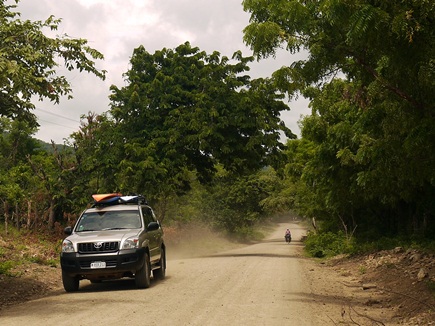
…before heading for Tola across a changing landscape. The roads became wider and faster, surfboards appeared strapped to flash 4x4s, and the signs suddenly all switched into English. We were clearly back in gringo holiday home territory.
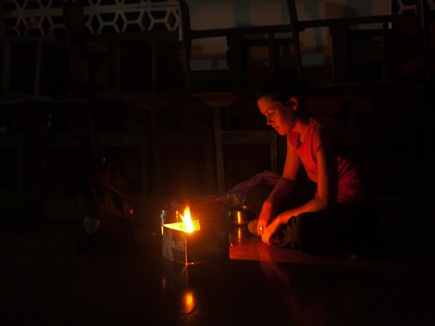
After a drowning in a mid-afternoon thunderstorm, we arrived in Rivas tired and soggy. Feeling cheap, we thought we'd try our luck at the local bomberos (fire station) – who sure enough were happy to let us fire up the stove and crash on their floor…
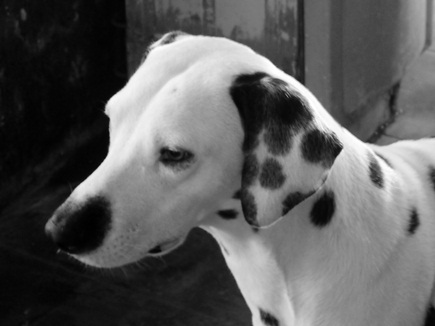
…all under the watchful eye of their dalmatian, Capitán. But we were more fascinated by a particularly memorable fireman, who our friend Andy had encountered and photographed when he stayed here a few weeks before. We wondered if we were in for a repeat performance, and sure enough…
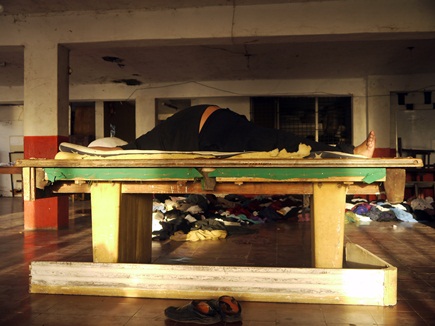
…here he is. Possibly the fattest fireman you'll ever see, snoring away peacefully on the pool table. It was all very Nicaraguan really – a flat green plain punctuated by a perfect volcanic cone. Apparently (and I'm not sure how this was physically possible), he actually shared the pool table with another guy when Andy was there – maybe since then they've had a falling out over one of them stealing the covers…
Isla de Ometepe
July 16th, 2012
It’s taken me a few years to admit it but I will finally state that boats and I just don’t agree. Being of a weak-stomached constitution, I get seasick at the slightest swell and usually feel a desperate urge to jump off and swim for the horizon. That all bodes well for the forthcoming FIVE day sailing trip between Panama and Columbia then…hmmm, let’s see how that pans out.
Nevertheless, I love islands and the boat journey that stood between me and Ometepe, nauseating as it was, didn’t put me off the tranquil wonders of this beautiful island on Lake Nicaragua. Perfect for cycling, being only 31km long and at its maximum only 10km wide, we were tempted by its two majestic volcanoes, and the prospect of some lakeside riding.
Sarah
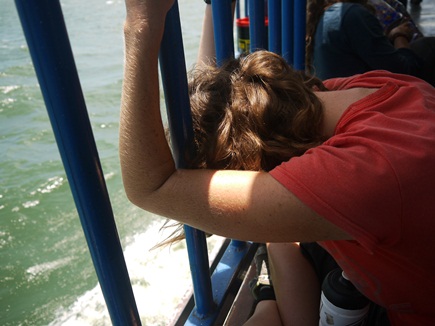
Hanging on for dear life, closing my eyes and thinking of England: all ineffective ways to ignore seasickness.
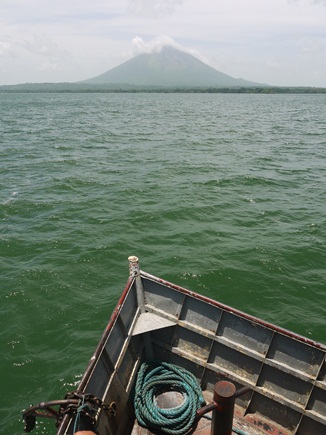
An hour later and the first of the island's two volcanoes came into view and I knew we were in for some picturesque riding.
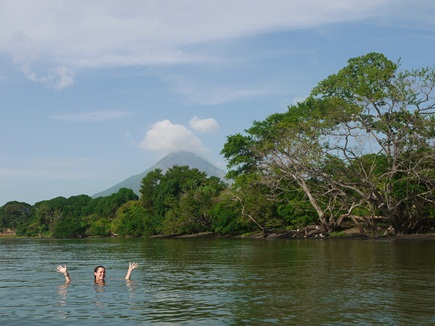
Shortly after arriving on the island, the seasickness having abated a little, we dipped into the lake and had the cool calm waters pretty much to ourselves.

Over the last year, we've got used to people stopping in their tracks to stare at us and the bikes as we trundle past – perhaps it's the lycra shorts – and these kids on the island were no different, seemingly oblivious to the beautiful backdrop, they stood open mouthed as we passed them by.
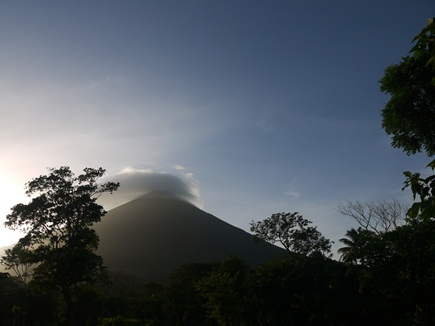
The sun starts to go down behind the bigger of the two volcanoes, Concepción, as we ride to our first destination. On the way we see howler monkeys, herons, hundreds of butterflies and hoardes of lush vegetation with stunning tropical flowers sprouting out of soil made fertile from volcanic ash. Apparently, Concepción is considered the “finest volcano cone” in Central America…high praise indeed.
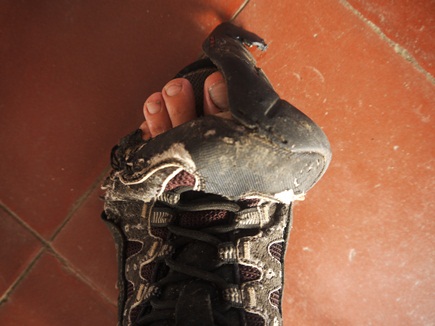
We might be in a Central American paradise, cycling past stunning natural wonders but the practicalities of the trip still have to be attended to. James' shoes suffer the consequences of too much Alaskan rain, a year of riding in all conditions and then the final nail in coffin was the hike up another volcano, Santiaguito in Guatemala, in May. With a new pair on order for collection in Panama City, these will have to make do until then, so out comes the duct tape…

Day two on the island saw us take a southern loop around the second, smaller volcano, Maderas. The road was dirt and pretty rocky at times through tiny villages and right along the lake.

Aside from James taking a dramatic head-first tumble into a rocky ditch like this one, it was the perfect Sunday afternoon ride.

We camped at Finca Magdalena, an organic coffee farm, and finished the day with hot strong Nicaraguan coffee and fried plantains with fresh mild cheese.
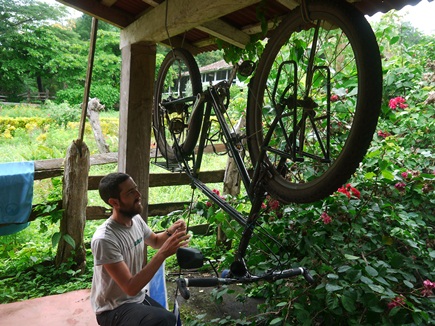
A relaxing third day was marred slightly when it began with a frustrating and sweaty hour tring to retrieve a pack of spare spokes that had been stored in James' seat post. With limited places to put things, we smugly thought that storing them here would be smart, until we realised that they'd slipped down further than we could reach and the only way to get them out was a “chopsticks” manoeuvre whilst the bike was hung upside down. And yes, we did receive some very curious looks from the staff and other guests at the finca.
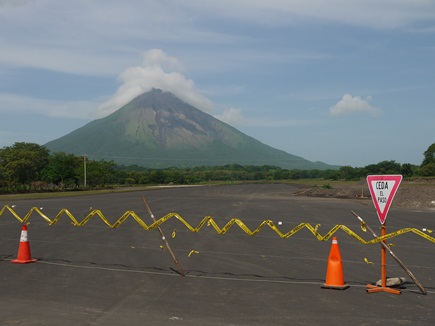
It's not the volcano cordoned off here – although Concepción is remarkably active, the last eruption being in 2010 – the taped area is the building site for an airstrip. If/when this becomes a reality, an influx of tourists by air looks likely to change the laid back unspoilt feel of the island.
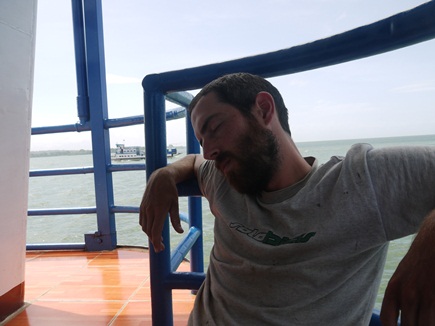
A rain shower and a night's camping at Charco Verde rounded off the trip and we headed for an early morning ferry to continue our route south through Nicaragua, hoping that we might catch up with some nesting turtles on the Pacific coast. It was a smoother journey back to the mainland but still, James copes with ferry crossings far more calmly than I do…maybe I'll try his snoozing technique next time we have to get on a boat.
Magical turtles
July 20th, 2012

One of only seven beaches where mass arrivals of nesting turtles occur, Reserva la Flor is a beautiful spot. As the sun goes down, we prepare to walk the beach and scan for turtles arriving to lay their eggs – over 100,000 of them use this beach to nest every year.
In the wrong place at the wrong time to see the migrating whales in Baja California back in November, we were determined not to miss a chance to see nesting turtles in Central America. So after Ometepe, we crossed back over to the Pacific coast of Nicaragua to visit Reserva La Flor. Olive Ridley turtles begin “arribadas”, mass arrivals, here in vast numbers in July so we were hoping to get lucky and see some ladies land on the beach to lay their eggs. A lovely dirt road ride took us from San Juan del Sur to Reserva la Flor, where a real treat lay in store for us.
The warden of the reserve waived our camping fee and only charged us half price to enter the reseve – he seemed shocked and amused when we showed up on bikes. We didn’t ask for any favours but it’s always so nice when someone warms to us simply because of the way we’re travelling. We spent the night camped outside the military dorms; they have a 24 hour military armed guard here to protect the turtles’ eggs from poachers.
Under a beautiful sky packed with stars, we are lucky to see an Olive Ridley turtle make her way back to the ocean having laid her eggs and another enormous Green Turtle, who also use the beach, in the process of nesting as we and other visitors look on. No flash photography is allowed as it disturbs the mothers so without the camera, we watch breathlessly as these amazing creatures follow their nesting patterns which haven’t changed for thousands of years.
There is no mass arrival on the night that we’re there but we feel privileged to have seen these two turtles at all. Little are we to know that the next morning, we’re in for another exceptional treat – this time with the beach to ourselves…
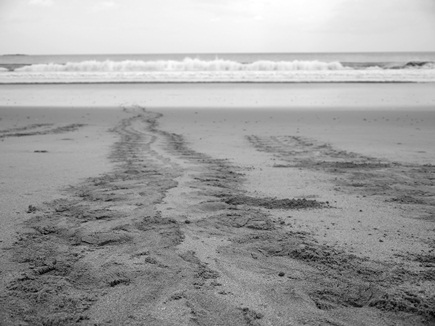
We wake at 6am to be told that during the night over 200 turtles came to lay eggs on the beach. We're in luck as the warden tells us to head straight to the beach where an Olive Ridley is making her nest in the daylight. Tell-tale tracks lead us to where the turtles have exited and returned to the ocean…

…and to the Olive Ridley who has begun digging her nest, under the watchful eye of one of the soldiers. These turtles take less than an hour to lay about 100 eggs and might come back a number of times during one season.

It's tiring work as the turtle has to dig out a hole in the sand deep enough to hold her eggs with just her flippers. She stops every few moments to take a deep breath and lets out a weary sigh before carrying on. She looks for all the world like she'd really rather be doing something else.
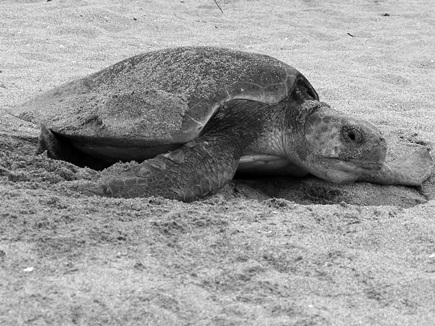
Now she has laid the eggs, it is time to cover them over and pack them down to give them the best chance. The turtle launches herself up and down onto the sand to pack it down making an odd thumping sound and looking most ungainly. These creatures are so much more graceful once in the water.

And the result of her labour of love: a nest of disturbed sand. It will be 50-60 days before the eggs are ready and then the babies will hatch all at once to ensure a greater chance of survival. If they survive the dash into the ocean (and are not defeated by sun, predators, poachers or dehydration first) they will travel as far as Alaska and Chile before the females return here to nest as their mothers have done.
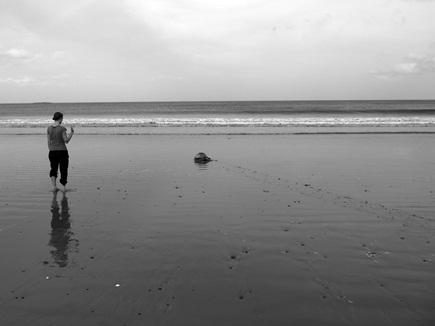
… while I follow behind to wave her off, pinching myself at how lucky we were to have witnessed this fascinating and humbling ritual.
Sarah
Costa Rica: hubs, hounds – and hospitality
August 10th, 2012
A broken Rohloff hub. An angry, biting dog. Daily drenchings as the rainy season switched up a gear. Roads blocked by landslides. A doubling of our daily costs with a return to US prices. To borrow a phrase from our good friend Lee, Costa Rica was, at times, something of a shit show.
It may just have been our run of bad luck, but Costa Rica didn’t quite charm us in the way its northerly Central American neighbours had. With its saturation of “eco-resorts”, zip lines (I’m pretty sure you could zip line across the whole country if someone just joined them up) and “exclusive” gated retirement communities, at times it all just felt a little too clinical and characterless for our tastes.
Yet as always, once we got off the beaten track, we found the tropical paradise of the tour brochures, but refreshingly free from the drawl of American retirees. We were slowly seduced by secluded, postcard-perfect Caribbean beaches and sunsets; remote backroads snaking through lush rainforest where monkeys, sloths and toucans lurked above our heads; and the warmth of Tico hospitality.
James
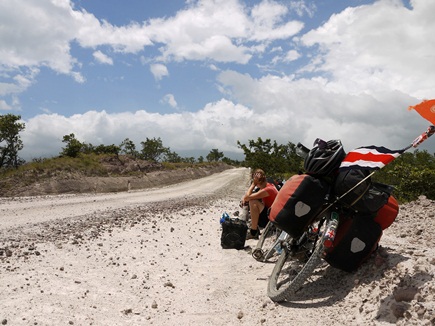
After our planned route down the Nicoya Peninsula was cut short by Sarah's wobbling Rohloff hub, we were forced to plot a more direct route towards the Caribbean. From Liberia we headed north-east up into Rincón de la Vieja National Park, through tunnels of blinding white rock.
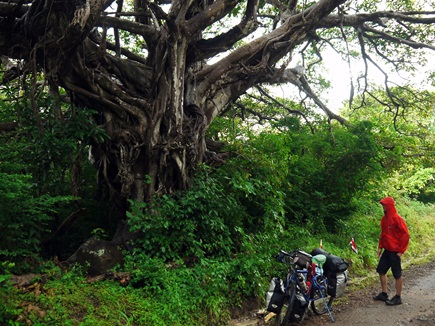
Daily soakings became the norm in Costa Rica as we climbed into the cloud forests, leaving us running for the nearest shelter – in this case an enormous tree strangled by incredible vines.
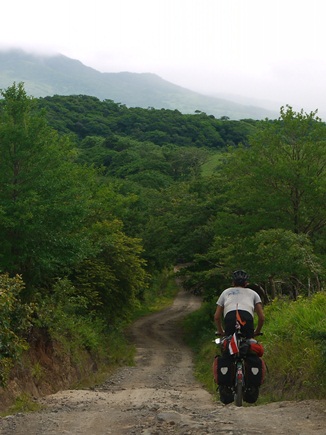
After an impromptu overnight stay with Vicente in Guayabo, we cut across towards Laguna Arenal via a network of tracks and the villages of San Bernardo and Santa Fé – through lush fincas…
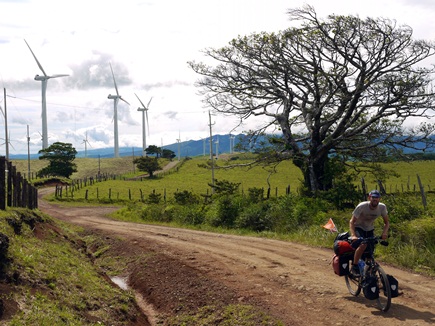
…and up through a series of wind farms towards Tierras Morenas. It was at one of these that I met my canine friend, who decided to take a chunk out of my thigh before I could say “rabies” – and certainly before I could judge whether he was foaming at the mouth or not.
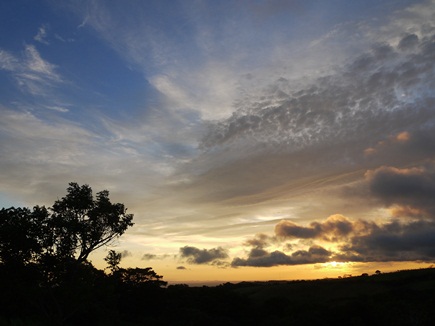
A dash to nearby Tilarán through a beautiful sunset, some hurried medical advice (thanks Steve!), and soon we were on a bus to the capital San José for the jab. Rabies was pretty unlikely, but for the sake of a few dollars, I didn't fancy taking the risk.
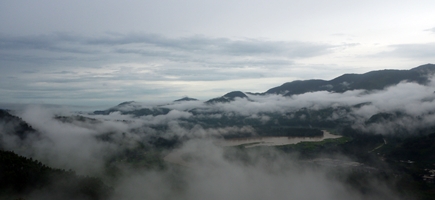
With another rabies jab due in a week's time and neither of us charmed by the concrete and fumes of San José, we decided to push on towards the Caribbean. We climbed up and out of the capital past thousands of pilgrims on their way to visit La Negrita (Costa Rica's patron saint) at the cathedral in Cartago, and into the beautiful Orosi Valley. Even by wet season standards, the rain was severe, with flooding rivers and landslides across the country.
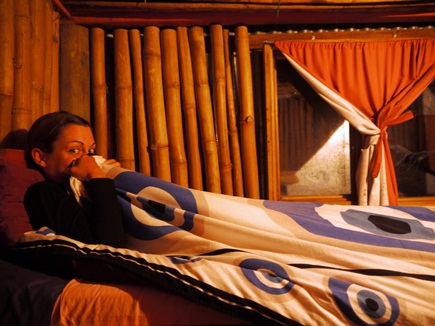
Not fancying being swept away ourselves in the tent, it didn't take much to tempt us into the Montana Linda hostel in Orosi. We dried out and warmed up in cosy bunks while the rain hammered outside.
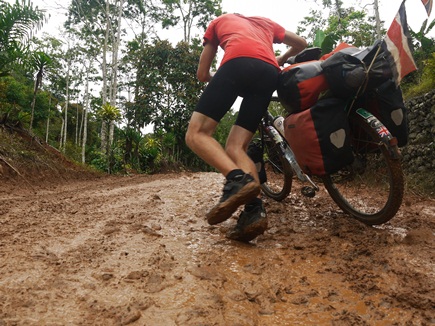
The next morning revealed the damage: roadblocks and landslides on the route to Siquirres, forcing us onto a muddy but beautiful detour up through coffee plantations and tiny villages.
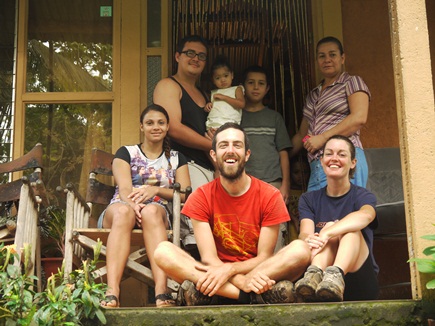
Costa Rican hospitality strikes again: Jami and her family spotted us scouting for somewhere to camp amongst the banana plantations on the road to Puerto Limón, and invited us to spend the night with them.
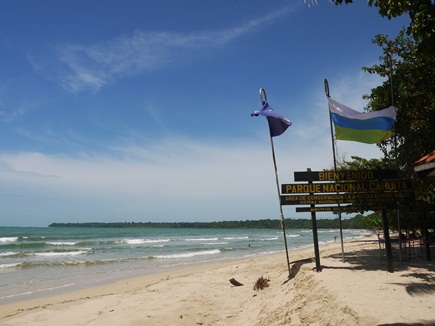
Finally we hit the Caribbean coast, and headed for Cahuita – a small, laid back hippy town with a string of beautiful beaches. Arriving on a severe sugar low after 100km in sweat-drenching humidity, we headed straight for refuelling at the local supermarket. There we met Daryl – and we must have presented a pitiful sight – because before long…
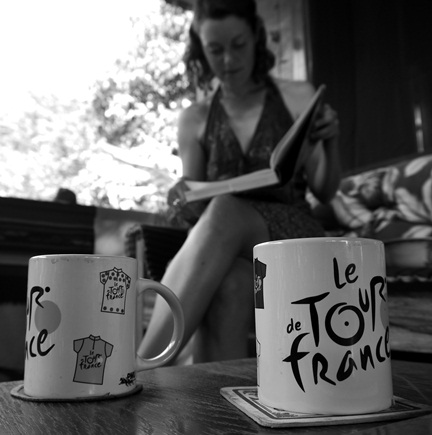
…we were collapsed on the terrace of his cool timber house just a few km up the road, toasting Bradley Wiggins' victory in Tour mugs, and with an invitation to stay and relax for a few days.
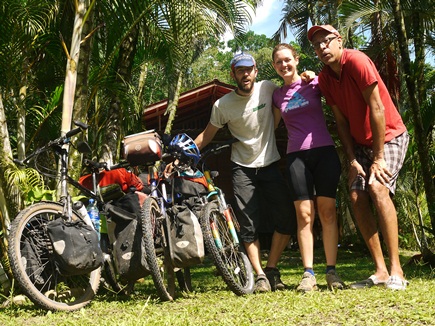
From New York City, Daryl is a former bike messenger turned tour guide who spends four months working flat out in the city, followed by two months decompressing in his Costa Rican jungle hideaway. To us, it looked like he had the perfect balance…
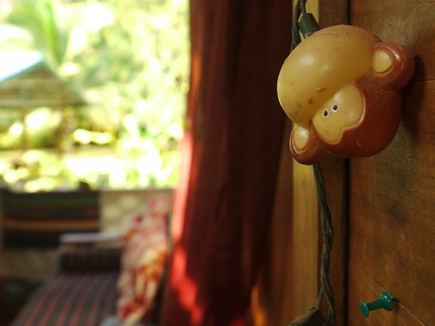
…and so we did our best to fit in. Apart from a day on the bus back to San José for my second jab, we relaxed on his shaded veranda, listened to the monkeys…

Eventually we dragged ourselves away, but only made it as far as the end-of-the-road village of Manzanillo before we were seduced into stopping again by the incredible sunsets…
Pleasantly surprised by Panamá
August 23rd, 2012
I hadn’t done a great deal of research on Panamá and except for the infamous canal, I confess I knew very little about it before we arrived at the Sixaola/Changuinola border. What I had heard, mostly from other cyclists ahead of us didn’t really inspire me; they suggested long, flat boring roads and that it wouldn’t be as vibrant as the rest of Central America. In short, the only thing I was expecting from Panamá was an anti climax.
Crossing the border I noted that not surprisingly, everything felt much the same as it had just a few minutes before, when we were in Costa Rica. I deliberately try hard not to compare one country with the next or to compare them all back to Mexico – which seems to have become something of a benchmark for this trip – but it’s impossible not to draw comparisons.
Within minutes of entering Panamá, we had (obviously) found a roadside stall selling pasties and cakes and were instantly and pleasantly surprised. They were cheaper and tastier than anything we’d found in Costa Rica, and came accompanied by engaging banter with a local taxi driver – the kind of which we both enjoy so much and had not found for a few weeks.
This set the tone for the rest of Panamá; having low expectations paid off as we found ourselves enjoying this little gateway country at the end of the North American continent far more than we had expected.
Sarah
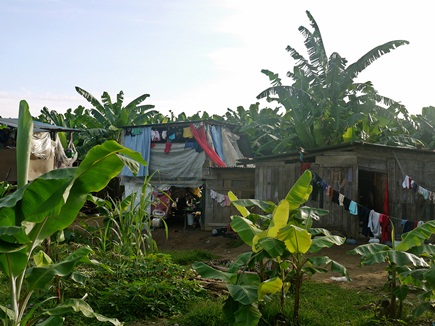
One significant similarity between Costa Rica and Panamá was the abundance of banana plantations along the Caribbean coast, with field upon field of banana trees and workers' shacks as far as the eye could see. Now the humble supermarket banana will hold new meaning for me as I have seen first-hand how many thousands of acres are required to meet our demand for this popular tropical fruit.
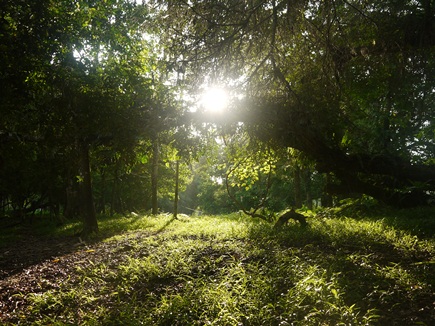
Our first night in Panama was spent in a dingy “love” hotel in Changuinola and the following morning we agreed to make an effort to avoid the sticky sheets and camp more if we could. By the end of the day we'd met our target: a beautiful river and a lovely wood. The river proved essential – having spent the hottest camping night of the trip so far, we used it the next day to bathe and wash our clothes.
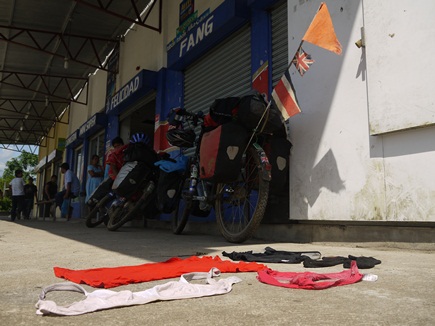
Those wet clothes needed drying on the run. Whilst I was inside doing the shopping, James decided that the hot baked concrete outside the supermarket was the perfect place to lay out my underwear! Needless to say the locals though it a little odd…
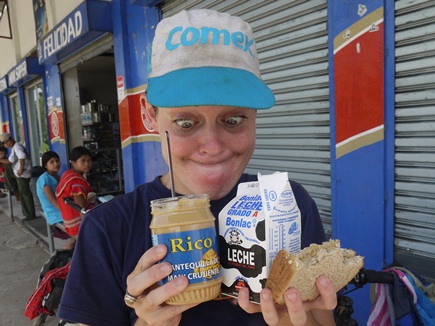
…even more so when I returned hysterically excited having found affordable peanut butter for the first time in seven months. The girls in the background of this picture can't quite understand what all of the fuss is about, but those of you reading our blog back when we started in the US will probably recall a love affair bordering on obsession with peanut butter, and so can appreciate my greedy eyes!
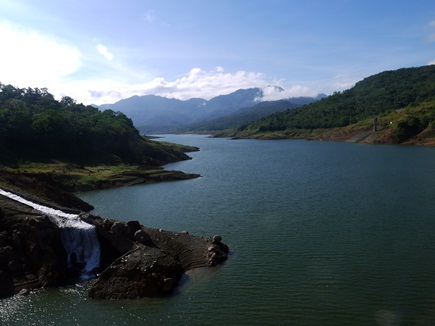
Fuelled by peanut butter, we spent all afternoon scaling the Cordillera Central to cross back from the Caribbean coast to the Pacific coast. Reaching the top we laid down the bikes, took a breather and enjoyed the views.
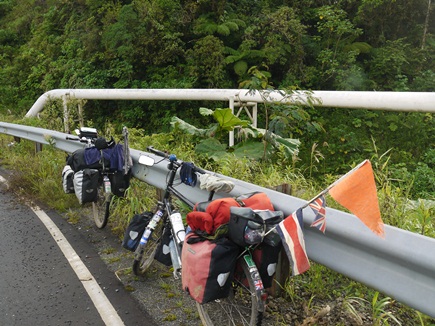
Here's a familiar sight. Back in July last year when we started the trip, we followed a pipeline carrying Alaskan oil hundreds of miles cross country to the Pacific Ocean. We weren't expecting to ever see the pipe again, least of all in Panamá. It seems the most cost effective way to get oil to the East Coast of the US is to send it all the way to Panamá by boat, pump it back into the pipes and across the narrowest land mass and then put it on a boat again in the Atlantic Ocean and send it back north.
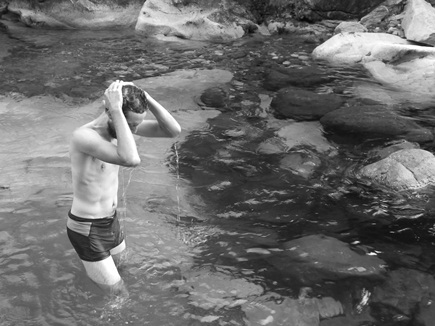
For the second night in a row, we found a great camping spot with a delicious river to take a chilly dip the next morning.
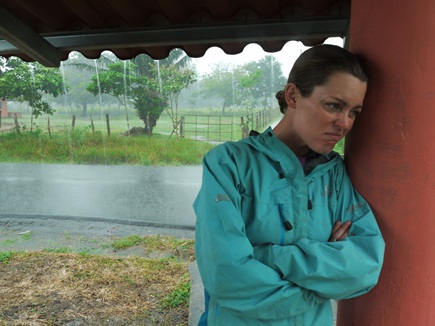
We descended from the mountains and got stuck in a downpour. Pulling into a bus stop outside of Gualaca as the heavens opened, we attempted to amuse ourselves for the next three hours as it showed no signs of letting up….
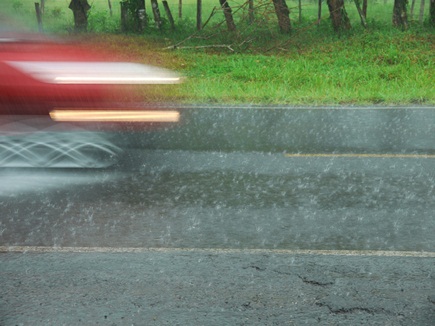
…James resorted to taking pictures of passing cars sloshing through the deep puddles while I sang all the songs I knew that featured the word “rain” at the top of my voice – with only two in my repertoire, it got pretty tedious.
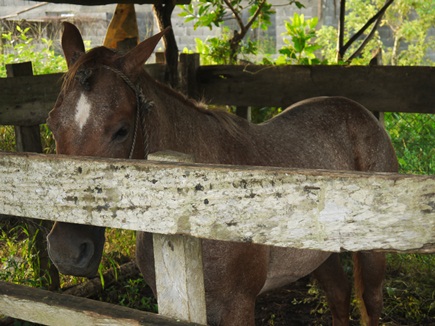
We had just decided to turn back to Gualaca and try to find a hotel when Manuel came out of a nearby house and invited us to stay. He turned out to be a true Panamanian cowboy taking part in rodeos and lasso competitions locally. I loved the stripped down simplicity of his life, from choosing to live alone after three disastrous marriages, right down to the fact that his horse was simply called “Horse”.
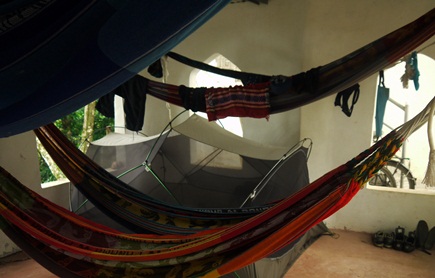
The following day the rain cleared and after an unwelcome detour to Davíd to get cash, we had a long day's ride back to the Pacific Coast. It was worth it though as at the road's end lay Isla Boca Grande, a tiny island reached by speedboat. We camped here amongst hammocks and howler monkeys.
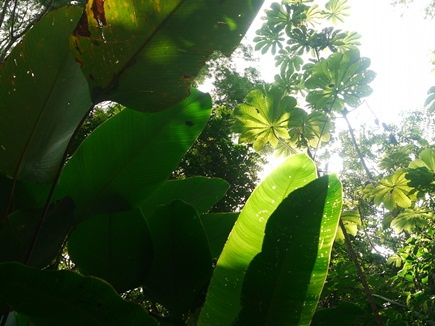
…and while away the afternoon looking at tropical plants and watching crabs scuttle across the sand.
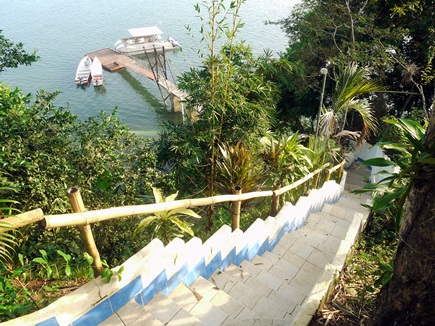
The entrance and exit to this lovely island wasn't quite so stress-free. An ambitious German architect designed this hideaway on the top of a hill and obviously added the staircase as an afterthought. Tiled, steep, slippery…not ideal conditions for carrying a bike up and down to a boat.

Leaving the coast behind, we headed inland and towards Panamá City. We took the turning for a well known cyclists' detour off the Interamericana towards Soná and started looking for somewhere to camp. Asking at a deserted aeronaval base really paid off. The marines there didn't just offer us a place to pitch the tent, they gave us our own air conditioned room in the barracks and fed us a tasty Panamanian dinner.
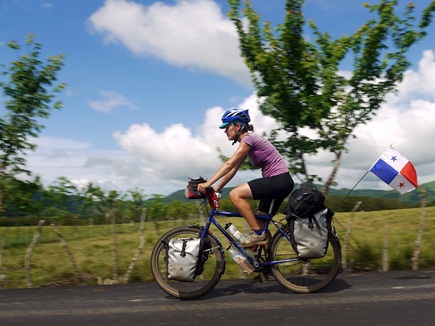
We underestimated ourselves and the flatness of Panamanian roads and made quicker progress than expected towards the city and our deadline date to meet James' brother, Ed, who was coming out to visit for a holiday. So with lots of extra days to spare, we did another dash down to the coast for a few more days on the Pacific….
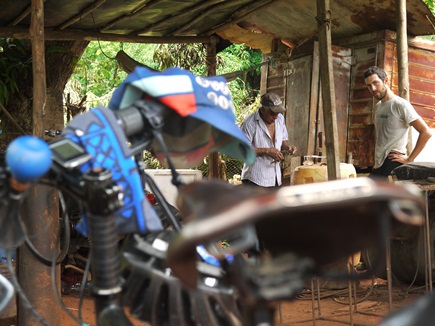
…stopping at a workshop along the way to fix one of James' broken bottle cages. This mechanic did a great job on a shoddy piece of kit that's hopefully been given a new lease of life.
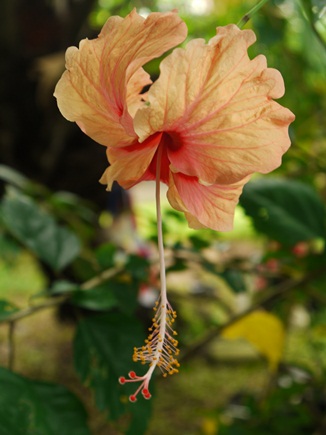
We whiled away a few days in Santa Catalina, camping in the pretty garden of Blue Zone hostel. Whilst there we bumped into two fellow PanAmerican touring cyclists. Australian Anna set off from Alaska in 2009 and is currently working in Santa Catalina, and Spaniard Salva, who is six years into an epic round the world journey, currently trying to cross the treacherous Darién Gap into Colombia.
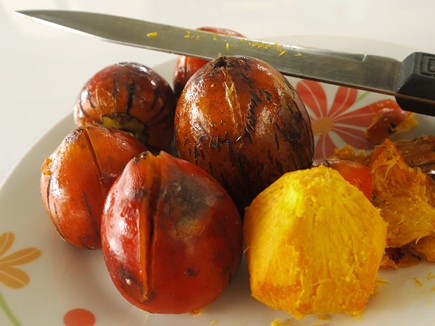
Sipping licuados at Omar's roadside stall on the way to Panama City was a real treat. It led to an invitation to camp and Omar cooked us a delicious Panamian dinner of grilled pork with pifa, the fruit of a local palm tree which tastes a bit like squash. He also entered into my country comparisons game, telling us that pifa in Panamá are traditionally served with salt, but in neighbouring Costa Rica and Colombia they are called something else and served with mayonnaise and honey respectively.
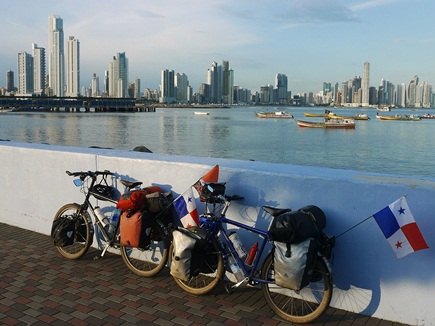
After a country of surprises, we found ourselves in Panamá City and at the end of the North American leg of our journey having clocked up 13,349kms in the 409 days since setting off from Anchorage last year. The final surprise in Panamá was the capital city itself, a disconcerting yet interesting mix of a string of Western skyscrapers, a dollop of Latin American spirit, a dose of restored Colonial buildings and a smidge of traditional fishing culture thrown in. This picture doesn't tell the full story as a snapped gear cable on James' bike that we couldn't fix resulted in us taking the bus for the final 300km….ah, there was the anti climax I was expecting from Panamá after all.
Panama City: end of a continent
August 25th, 2012
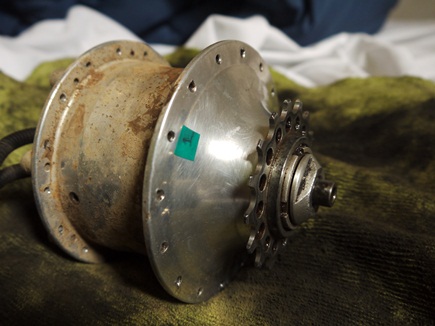
Bike problem no.1: Sarah's broken Rohloff hub, supposedly the “Rolls Royce” of gear systems for bike touring. With worn hub bearings, it's currently winging its way to Cycle Monkey in California – one of only two places in the world that can repair it. When I write that, it does seem like the most ridiculous choice of bike part ever for touring. Thing is, they're not meant to go wrong…
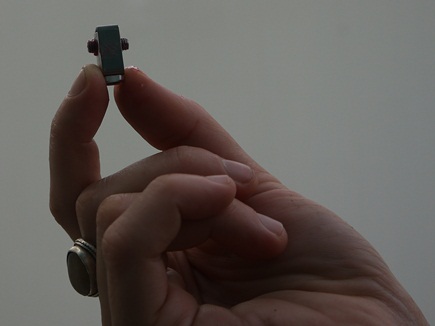
Bike problem no.2: my seized Rohloff bayonnet connector, which prevented us from changing a broken shifter cable and forced us into the bus for the last 300km into Panama City. Unsurprisingly, after a trouble-free first year, we're quickly falling out of love with our Rohloffs. Luckily we were in time to get an order in before my brother Ed (aka our kit mule), arrived…
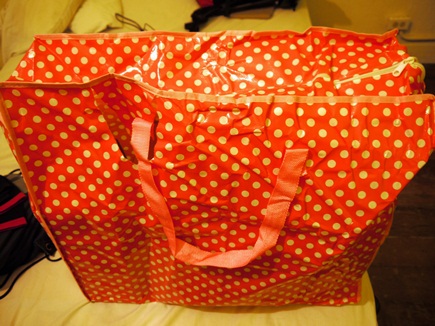
…bearing a lovely pink-spotted Santa's sack of replacement parts and spares. After a year of abuse in all weather, it seems our “kit honyemoon” is well and truly over, with things breaking and wearing out with increasing regularity.
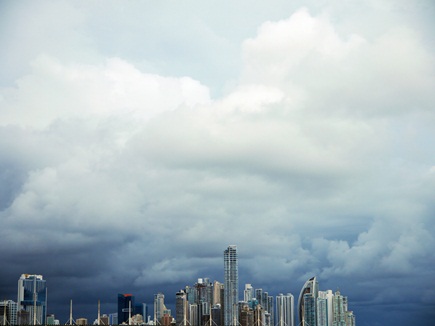
Panama City, perched at the end of Central America before the impenetrable jungle of the Darién Gap, is truly a city of contrasts: where a skyline of lego skyscrapers…

…meets Old World charm.
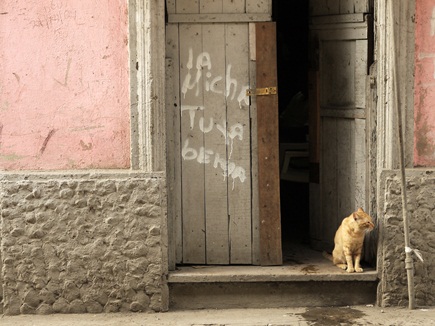
We opted for the quieter pace of the Casco Viejo (Old Town), away from the 6-lane motorways and shopping malls. Except it wasn't really that quiet, as the whole area is currently under massive renovation to turn the city into a tourist “destination” in it's own right.
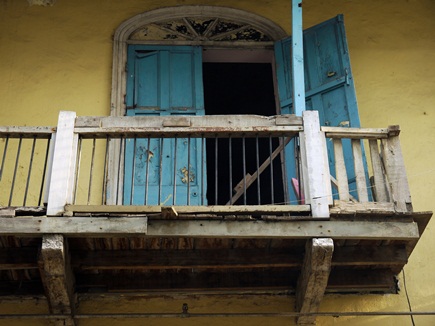
It reminded us of a mini Havana, Cuba – somewhere between Habana Centro and Habana Vieja, with steakhouses and boutique hotels gradually replacing the gloriously ramshackle wooden apartment buildings and balconies.
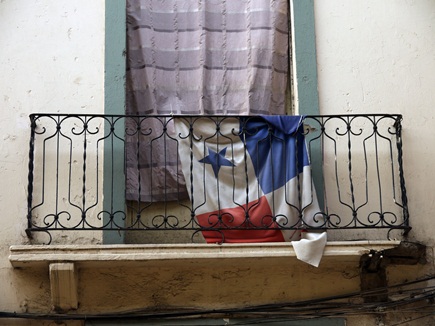
Above the diggers though you could still see signs of the original residents clinging onto their space…
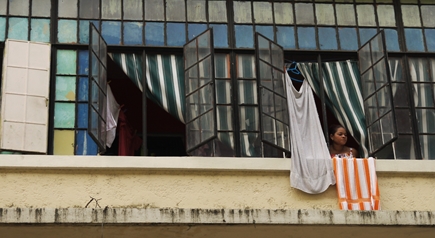
…and keeping an eye on proceedings below. You have to hope that in the rush to regenerate, the character and soul of the original Casco Viejo is not entirely lost – as we felt it had been in other colonial “gems” such as Antigua, Guatemala and parts of Oaxaca City, Mexico.
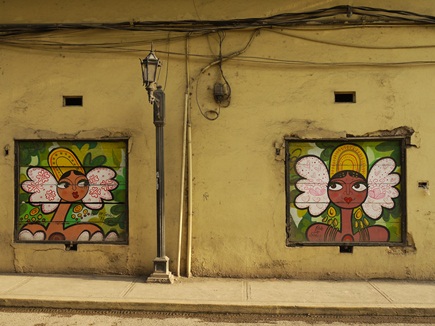
Down at street level, these murals by Panamanian artist Rolando de Sedas added a splash of colour…
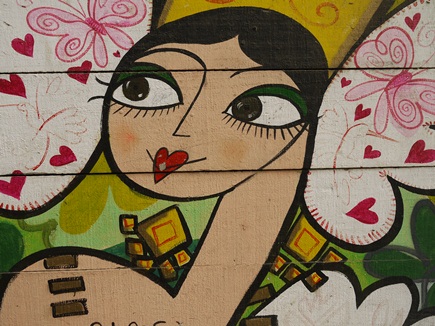
…and pouting Latina spirit.
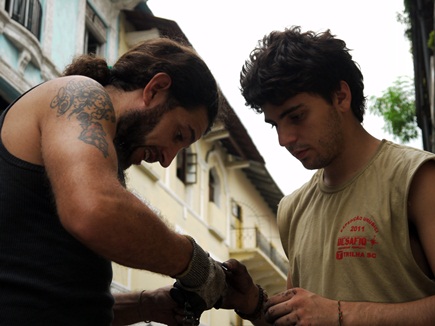
Walking around the Casco Viejo, we bumped into Jorge (with his Mexican wife María) and Jere, both Argentines on epic motorbike trips. Jorge has been on the road for over 10 years…
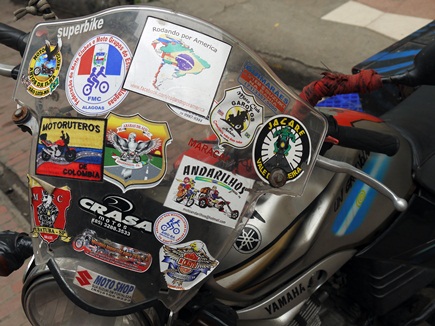
…while Jere is doing the reverse of our trip, heading north from Patagonia up to Alaska.

Our one day whistle-stop tour of Panama City with Ed started of course with food – a delicious lunch of ceviche and fried Corvina (sea bass) at the fish market.
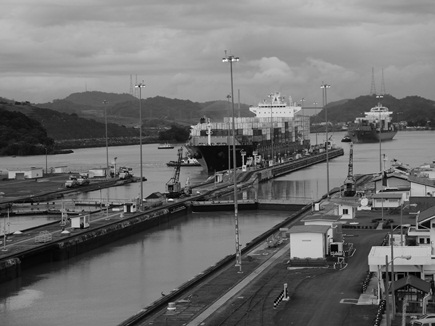
We couldn't visit Panama without visiting its most famous landmark – the Canal, and so we headed out to the Miraflores Locks to catch the afternoon's action. Although sceptical at how excited I could get about some big ships and a lock, it was actually fascinating to watch them line up from the Caribbean side…

…move into the lock with the help of some very cool tug trains, and slowly drop as the water level falls.
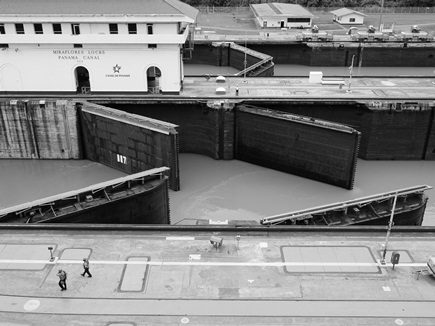
Finally the enormous gates opened…
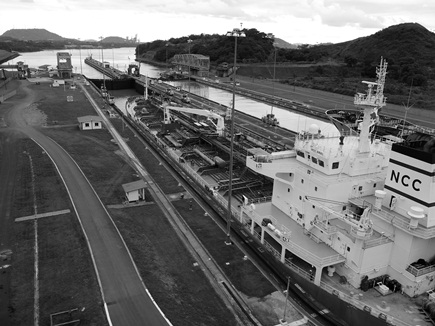
…and they inched their way out towards the Pacific, just 17m lower and their bank account $30,000 lighter.
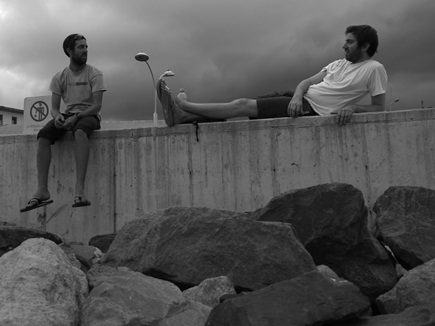
Back in the City, it was down to the front for over a year's worth of brotherly catch up…
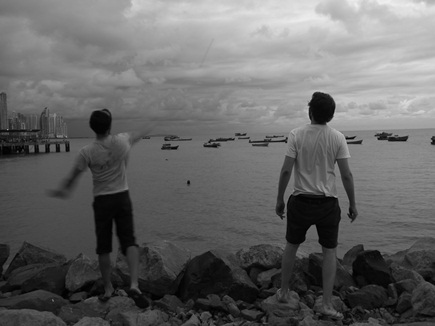
…followed by the first of many editions of the obligatory Butcher “bet you can't hit that” stone throwing game – just to re-establish bragging rights.
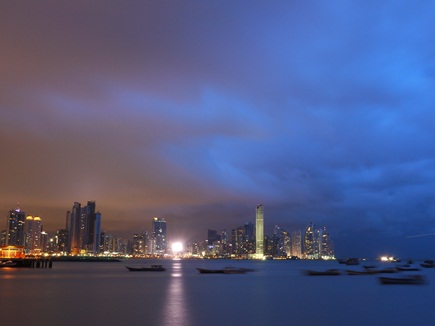
After taking in the surreal Panama City skyline by night, we called it a day – ready for an early start back over the Cordillera Central to the Caribbean, and the boat that will take us to Colombia and South America.
James
Sailing in the San Blas
August 31st, 2012
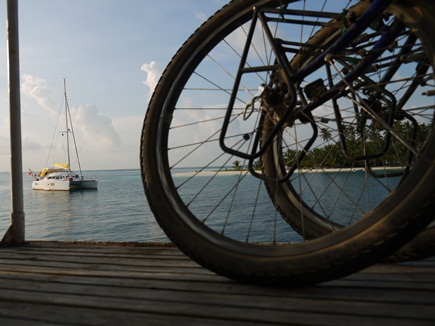
So we set sail from El Porvenir, Panamá to Cartagena, Colombia. The fact that the Darién Gap between Panamá and Colombia is an inhospitable and dangerous place to be riding a bike was the perfect excuse for us to load the bikes onto a boat and for James' brother Ed to join us for a holiday cruise across the Caribbean to the start of our next cycling leg in South America.
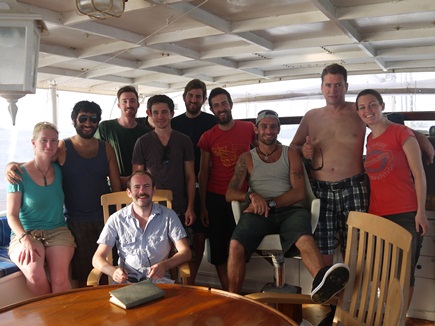
The eleven of us (Seamus is hiding!) who sailed together on the M/S Indpendence. A mix of nationalities and stories…we all rubbed along together very nicely. The boat has space for twenty four people but we were all grateful for it being less than half full.
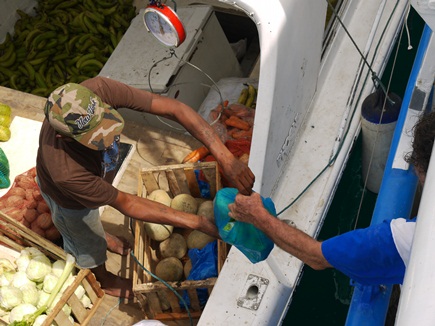
Once we were on board for our five day journey, the captain also needed to take on supplies. Handily, the fruit and veg boat pulled up alongside the Independence and he did a little bit of shopping….
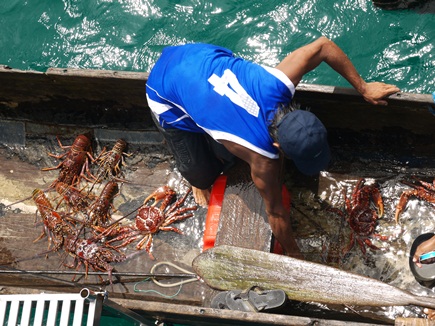
Then it was time to visit the next shop. This time it was the lobster man who was selling his catch from a dugout canoe. Our captain Michel bought us a lobster feast for the first night on board.
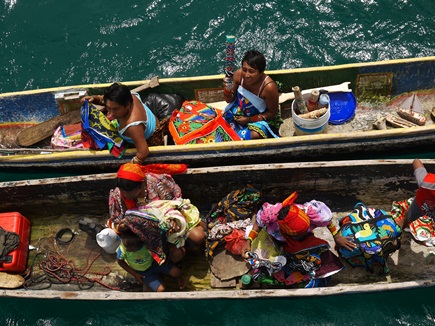
We spent three days sailing in the San Blas, a collection of 378 islands just off the coast of Panamá. 49 of the islands are home to the indigenous Kuna tribe who make their living fishing and selling food and souvenirs to boats like ours….
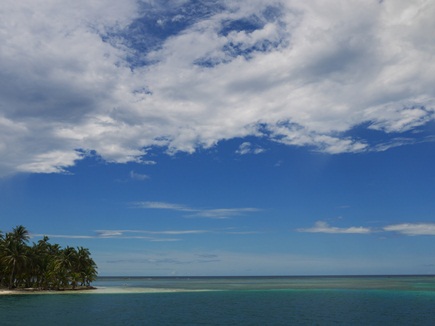
…while the uninhabited islands are just cocunut trees and blinding white sand. Close your eyes and think of your typical “tropical island paradise”…yep, exactly. I felt like we'd stepped into the pages of a luxury travel brochure when we woke up each morning to scenes like this.
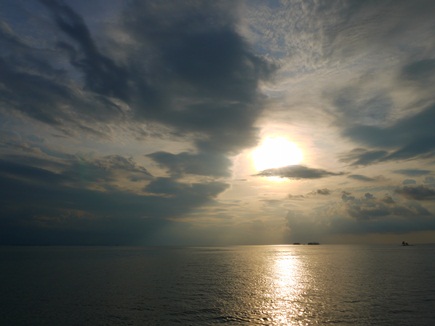
The days then took on a hypnotically laid back routine; spending our time basking in the sunshine and bathing in the pristine Caribbean: snorkelling, kayaking, eating and reading.
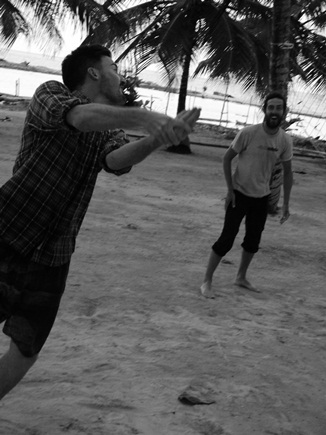
A little more activity on the evening of day two as we headed to one of the islands for a beach bbq. The more energetic of us dabbled with a spot of beach volleyball – Australian Mike showing us how it's done!
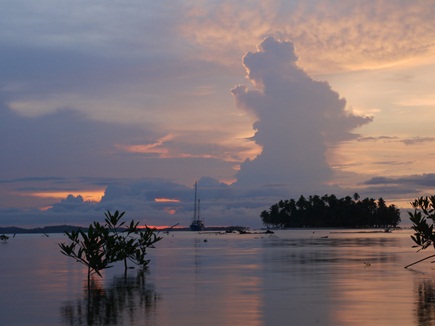
Having delicious grilled fish on the island, we could look back and admire our yacht from afar: the M/S Independence bobbing in the water as the sun goes down.
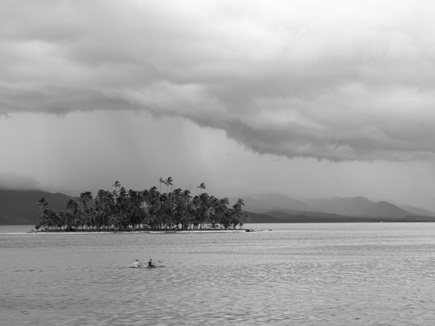
Dolphins came to visit on day three. Most of us watched from the boat but Mike and Seamus were lucky enough to be out on the kayak and gave chase for a close up view.
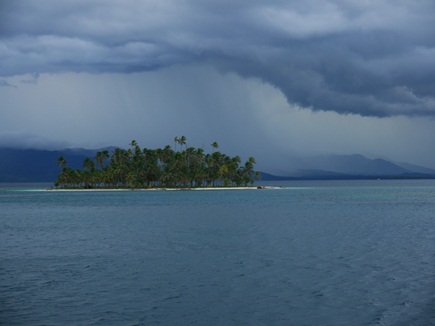
The dolphins beat a hasty retreat as black clouds started to gather; we could see a storm brewing and then someone spotted a tornado on the distant horizon. I half expected the captain to shout “batten down the hatches”! He wasn't quite so melodramatic but it was definitely time to move away from the San Blas and set sail for Colombia.
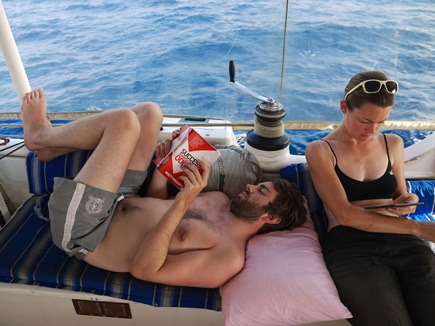
The storm never reached us and a calm day of open water sailing meant nothing more to do except read…
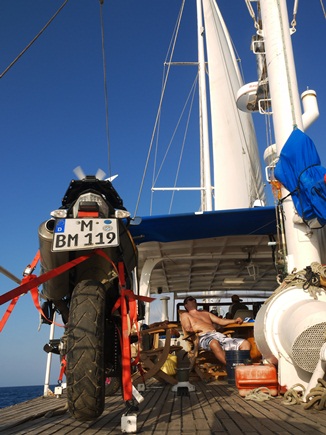
…and sleep. We weren't the only ones using the boat as a delivery service. In between snoozing on deck, Marcus kept close watch on his motorbike that he was shipping over to Colombia from Germany.

The rest of us had little to do as captain Michel took charge and navigated across the open water. It was a relief not to have to helplessly tackle ropes, sails and nautical language as we had done on the Sea of Cortez in Mexico back in December last year.
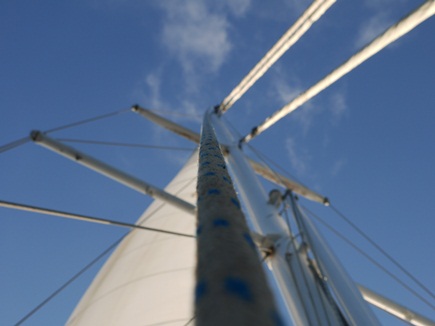
Despite being a sailing boat the wind wasn't right and we did the entire journey using the motor. Michel proclaimed this was the calmest crossing he had made in forty years – much to my relief; the sea sickness I was dreading never came.
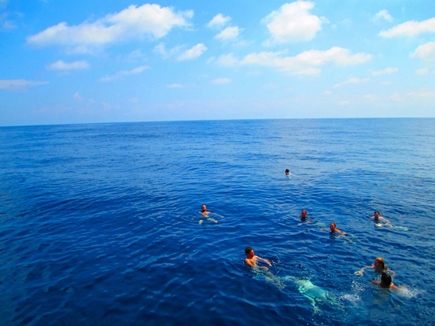
When Michel cautiously offered us the chance to swim in open water, peppered with warnings of sharks and other beasties, we jumped at the chance to take a delicious dip in the vast ocean. Thankfully all eleven of us came back out in one piece. (Photo: Dean Murphy)
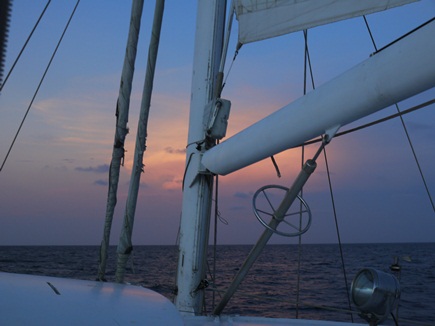
We made quick time sailing under the motor and as the sun went down on a full day spent in open water we were only a few hours from Cartagena, where we slept in the harbour.

The next morning, before we unloaded, there was just time for our quirky captain Michel to show Dean and the rest of a us a few essential self defence moves for survival in Colombia, and then we went our separate ways.
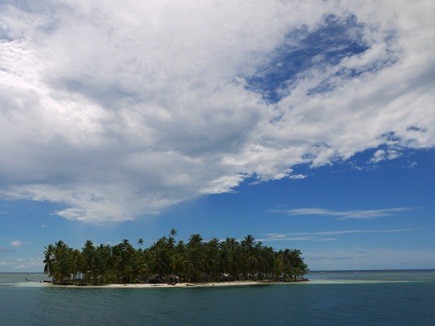
A final, gratuitous shot of the islands we fell in love with. The memorable boat journey was well worth the expense; blessed with fine weather, capable crew, good people, great food and exquisite scenery we couldn't have wished for a finer way to travel from one continent to the next.
Sarah
